
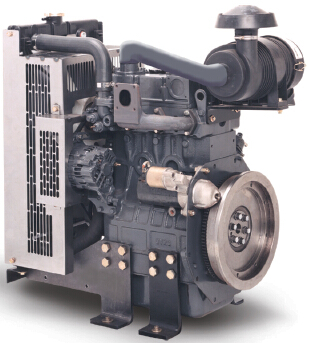
珀金斯珀金斯403F-15T、404F-22、404F-22T維修保養測試調整(英文)一
詳細描述
Systems Operation
Testing and Adjusting
403F-15T, 404F-22 and 404F-22T
Industrial Engines
EL (Engine)
EN (Engine)
EP (Engine)
This document is printed from SPI². Not for RESALE
![]()
![]()
![]()
![]()

Important Safety Information
Most accidents tha t involve produc t op eration, ma intena nc e and repair are caus ed by failure to
ob serve basic safety rules or precautions . An accident can often be avoided by recog nizing pote ntially
ha za rdous situations before an accident oc curs . A person mus t be alert to pote ntial ha za rds. This
person should also ha ve the ne cessary training, skills and tools to perform the se func tions properly.
Improper operation, lubrication, maintenance or repair of this product can be dangerous and
could result in injury or death.
Do not operate or perform any lubrication, maintenance or repair on this product, until you have
read and understood the operation, lubrication, maintenance and repair information.
Sa fety precautions and warning s are provided in this ma nua l and on the produc t. If the se ha za rd
warning s are not he eded, bod ily injury or death could oc cur to you or to othe r persons .
The ha za rds are identified by the “Safety Alert Symb ol” and followed by a “Signa l Word” suc h as
“DANGER”, “WARNING” or “CAUTION”. The Sa fety Alert “WARNING” label is shown below.
The me aning of this safety alert symb ol is as follows:
Attention! Become Alert! Your Safety is Involved.
The me ssage tha t appears und er the warning explains the ha za rd and can be either written or
pictorially presente d.
Op erations tha t ma y caus e produc t dama ge are identified by “NOTICE” labels on the produc t and in
this pub lication.
Perkins cannot anticipate every possible circumstance that might involve a potential hazard. The
warnings in this publication and on the product are, therefore, not all inclusive. If a tool, procedure,
work method or operating technique that is not specifically recommended by Perkins is used,
you must satisfy yourself that it is safe for you and for others. You should also ensure that the
product will not be damaged or be made unsafe by the operation, lubrication, maintenance or
repair procedures that you choose.
The informa tion, specifications , and illustrations in this pub lication are on the basis of informa tion tha t
was available at the time tha t the pub lication was written. The specifications , torque s, pressure s,
me asure me nts , adjustme nts , illustrations , and othe r items can cha ng e at any time. These cha ng es can
affect the service tha t is given to the produc t. Ob tain the comp lete and mos t current informa tion before
you start any job. Pe rkins dealers or Pe rkins distributors ha ve the mos t current informa tion available.
When replacement parts are required for this
product Perkins recommends using Perkins
replacement parts.
Failure to heed this warning can lead to prema-
ture failures, product damage, personal injury or
death.
This document is printed from SPI². Not for RESALE
![]()
![]()
KENR9144
3
Table of Contents
Table of Contents
Water Pump - Inspect................... .................. 73
Basic Engine
Systems Operation Section
Piston Ring Groove - Inspect............. ............. 75
Connecting Rod - Inspect................ ............... 75
Connecting Rod Bearings - Inspect........ ........ 76
Main Bearings - Inspect................. ................. 76
Cylinder Block - Inspect................. ................. 76
Cylinder Head - Inspect................. ................. 77
Piston Height - Inspect.................. .................. 77
Flywheel - Inspect...................... ..................... 78
Flywheel Housing - Inspect .............. .............. 79
Gear Group - Inspect................... ................... 80
General Information..................... ..................... 4
Glossary of Electronic Control Terms ....... ...... 10
Electronic Control System Components..... .... 14
Fuel System.......................... .......................... 31
Air Inlet and Exhaust System............. ............. 35
Clean Emissions Module................ ................ 37
Lubrication System..................... .................... 40
Cooling System ....................... ....................... 41
Basic Engine.......................... ......................... 42
Electrical System...................... ...................... 43
Electrical System
Alternator - Test ....................... ....................... 81
Battery - Test.......................... ......................... 82
Charging System - Test ................. ................. 82
Coolant Temperature Switch - Test......... ........ 82
Electric Starting System - Test............ ............ 82
Engine Oil Pressure Switch - Test ......... ......... 83
Fuel Shutoff Solenoid - Test.............. .............. 83
Glow Plugs - Test...................... ...................... 84
Testing and Adjusting Section
Fuel System
Fuel System - Inspect................... .................. 46
Air in Fuel - Test....................... ....................... 46
Finding Top Center Position for No. 1 Piston. . 47
Fuel Injection Timing - Check ............. ............ 47
Fuel Transfer Pump - Test ............... ............... 48
Fuel Injector - Test ..................... ..................... 49
Fuel Quality - Test...................... ..................... 52
Fuel System - Prime.................... ................... 52
Gear Group (Front) - Time............... ............... 52
Governor - Adjust...................... ...................... 52
Index Section
Index................................ ............................... 86
Air Inlet and Exhaust System
Air Inlet and Exhaust System - Inspect...... ..... 59
Diesel Particulate Filter - Clean........... ........... 59
Wastegate - Test....................... ...................... 60
Exhaust Cooler (NRS) - Test (If Equipped)... .. 61
Compression - Test..................... .................... 62
Engine Valve Lash - Inspect/Adjust........ ........ 62
Valve Depth - Inspect................... ................... 65
Valve Guide - Inspect................... ................... 66
Lubrication System
Engine Oil Pressure - Test............... ............... 67
Engine Oil Pump - Inspect............... ............... 67
Excessive Bearing Wear - Inspect......... ......... 68
Excessive Engine Oil Consumption - Inspect. 69
Cooling System
Cooling System - Check (Overheating)..... ..... 70
Cooling System - Inspect................ ................ 71
Cooling System - Test................... .................. 71
Water Temperature Regulator - Test........ ....... 73
This document is printed from SPI². Not for RESALE
![]()
4
KENR9144
Systems Operation Section
Systems Operation Section
The engine oil pump is a gerotor type pump. The
engine oil pump is located in the center of the idler
gear. The engine oil pump sends lubricating oil to the
main oil gallery through an oil relief valve that is
located on the right side of the cylinder block. The
rocker arm levers receive pressurized oil through an
externally located oil line. The oil line runs from the
main oil gallery to the cylinder head.
i04903822
General Information
Coolant from the bottom of the radiator passes
through the belt driven centrifugal water pump. The
coolant is cooled by the radiator and the temperature
is regulated by a water temperature regulator.
Engine Description
Note: When you are ordering new parts, refer to the
engine identification number in order to receive the
correct parts. Refer to the Operation and
Maintenance Manual, “Product Identification
Information” for the correct numbers for your engine.
Engine Model Views
The following model views show typical features of
the 403F-15T, 404F-22, and 404F-22T engines. Due
to individual applications, your engine may appear
different from the illustrations.
The 403F-15T, 404F-22, and 404F-22T engines are
diesel engines that are controlled with a mechanically
actuated fuel injection pump. The engine cylinders
are arranged in-line.
The cylinder head assembly has one inlet valve and
one exhaust valve for each cylinder. Each cylinder
valve has a single valve spring. The pistons have two
compression rings and an oil control ring.
It is important to ensure the correct piston height so
that the piston does not contact the cylinder head.
The correct piston height also ensures the efficient
combustion of fuel which is necessary in order to
conform to requirements for emissions.
The crankshaft for the 403F-15Tengines have four
main bearing journals. The crankshaft for the 404F-
22, and 404F-22Tengines have five main bearing
journals. End play for all the engines is controlled by
the thrust washers that are located on the rear main
bearing. The 403F-15 engine has aluminum bearing
caps on the rear main bearing that act as thrust
washers.
The timing gears are stamped with timing marks in
order to ensure the correct alignment of the gears
during assembly. When the No. 1 piston is at top
center compression stroke, the teeth that are
stamped on the crankshaft gear and the camshaft
gear will be in alignment with the idler gear.
The crankshaft gear turns the idler gear which then
turns the camshaft gear.
The fuel injection pump and the fuel priming pump are
mounted on the cylinder block. Both pumps are
operated by the camshaft lobes.
The fuel injection pump conforms to requirements for
emissions. Adjustments to the fuel injection pump
timing and high idle should only be made by trained
personnel. The fuel injection pumps have mechanical
governors that control the engine rpm.
This document is printed from SPI². Not for RESALE
![]()
KENR9144
5
Systems Operation Section
403F-15T
Illustration 1
g03246538
Typical example
This document is printed from SPI². Not for RESALE
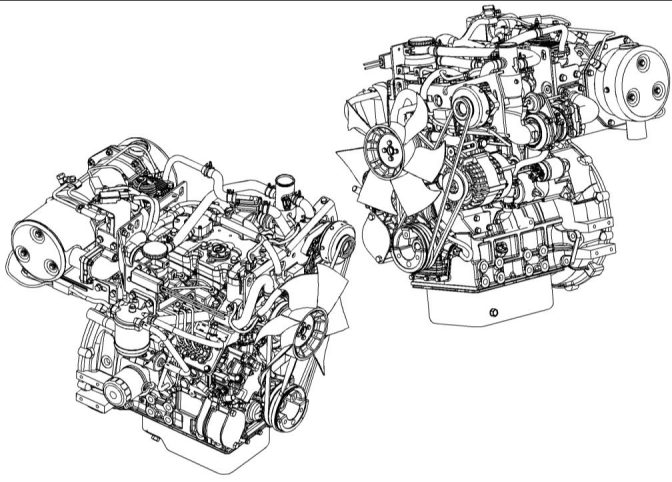
![]()
![]()
6
KENR9144
Systems Operation Section
404F-22
Illustration 2
g03246558
Typical example
This document is printed from SPI². Not for RESALE
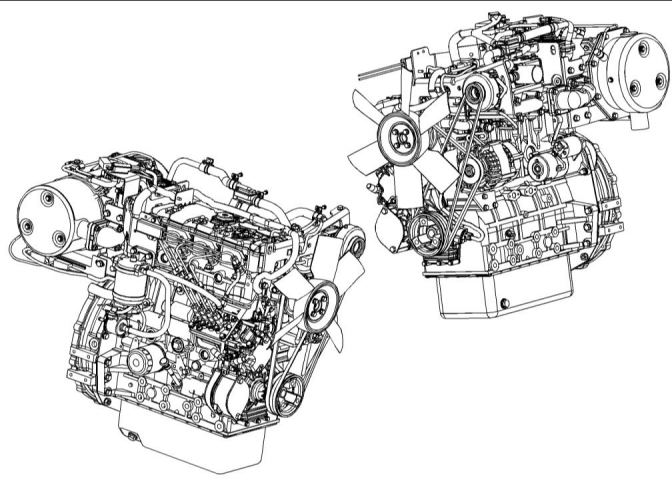
![]()
![]()
KENR9144
7
Systems Operation Section
404F-22T
Illustration 3
g03246676
Typical example
(1) Top oil filler
(2) Fan
(3) Side oil filler
(4) Cylinder block drain plug
(5) Oil gauge (Dipstick)
(6) Rear oil drain plug
(7) Oil filter
(8) Electric fuel pump
(9) Secondary fuel filter
This document is printed from SPI². Not for RESALE

![]()
![]()
8
KENR9144
Systems Operation Section
Illustration 4
g03246563
Typical example
(10) Air intake
(14) Flywheel housing
(15) Starting motor
(16) Solenoid for starting motor
(17) Front oil drain plug
(18) NOx reduction system cooler
(19) Coolant outlet
(11) Turbocharger
(12) Aftertreatment system
(13) Flywheel
This document is printed from SPI². Not for RESALE
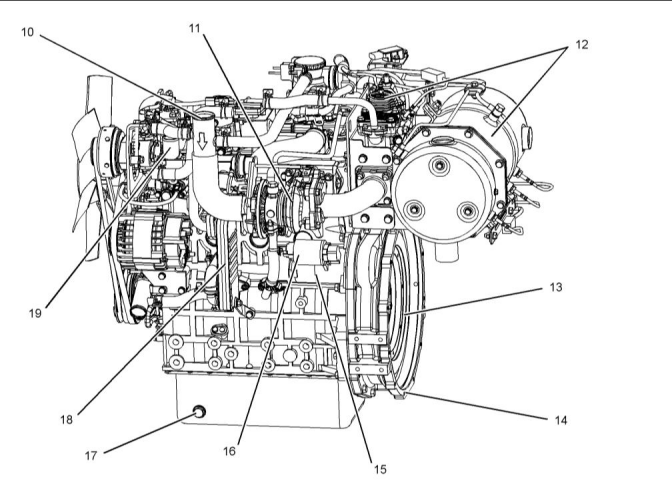
![]()
![]()
KENR9144
9
Systems Operation Section
Illustration 5
g03249056
Typical example
(20) Engine crankcase breather
(21) Rear lifting eye bracket
(22) Air pump
(23) Air pump drive belt
(24) Alternator
(25) Fan and alternator drive belt
(26) Coolant intake
(27) Water pump
(28) Front lifting eye
This document is printed from SPI². Not for RESALE
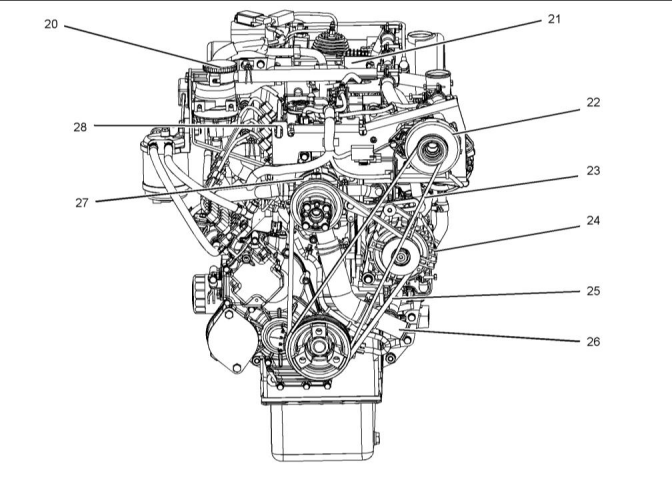
![]()
![]()
10
KENR9144
Systems Operation Section
Loose Components for the Engine
Alternating Current (AC) – Alternating current is an
electric current that reverses direction at a regular
interval that is reoccurring.
ARD Air Pump – The ARD air pump provides a
pressurized supply of air to the ARD combustion
chamber
ARD Air Pump Relay – The ARD air pump relay
controls the operation of the ARD air pump.
ARD Glow Plug – The ARD glow plug ignites the fuel
that is injected into the ARD combustion chamber.
ARD Glow Plug Relay – The ARD glow plug relay is
controlled by the ECM in order to provide power to
the ARD glow plug in the ARD combustion chamber.
Before Top Center (BTC) – BTC is the 180 degrees
of crankshaft rotation before the piston reaches the
top center position in the normal direction of rotation.
Boost Pressure – The difference between the
turbocharger outlet pressure and atmospheric
pressure is commonly referred to as boost pressure.
The sensor for the intake manifold air pressure
measures the amount of boost.
Breakout Harness – The breakout harness is a test
harness that is designed to connect into the engine
harness. This connection allows a normal circuit
operation and the connection simultaneously
provides a Breakout T in order to measure the
signals.
Illustration 6
g03271819
Typical example
Bypass Circuit – A bypass circuit is a circuit that is
used as a substitute circuit for an existing circuit. A
bypass circuit is typically used as a test circuit.
(32) Electronic Control Unit (ECM)
(33) In line fuel filter
CAN Data Link (see also J1939 CAN Data Link) –
The CAN Data Link is a serial communications port
that is used for communication with other
microprocessor-based devices.
i05181776
Glossary of Electronic Control
Terms
Clean Emissions Module (CEM) – Refer to
“Aftertreatment” .
Active Diagnostic Code – An active diagnostic code
alerts the operator or the service technician that an
electronic system malfunction is currently present.
Refer to the term “Diagnostic Code” in this glossary.
Code – Refer to “Diagnostic Code” or “Event Code”
.
Cold Mode – Cold mode is a mode for cold starting
and for cold engine operation. This mode is used for
engine protection, reduced smoke emissions, and
faster warm-up time.
Aftertreatment – Aftertreatment is a system that is
used to remove pollutants from exhaust gases. The
system consists of the regeneration system, a diesel
oxidation catalyst, and a diesel particulate filter.
Communication Adapter Tool – The communication
adapter provides a communication link between the
ECM and the Electronic Service Tool.
AftertreatmentRegeneration Device (ARD) – This
item is sometimes referred to as the regeneration
system. The ARD is a device that intermittently raises
the temperature of the exhaust gases in order to
regenerate the diesel particulate filter.
Component Identifier (CID) – The CID is a number
that identifies the specific component of the electronic
control system that has experienced a diagnostic
code.
Air-To-Air Aftercooler – An air-to-air aftercooler is a
device that is used on turbocharged engines in order
to cool inlet air that has undergone compression. The
inlet air is cooled after the inlet air passes through the
turbocharger. The inlet air is passed through an
aftercooler (heat exchanger) that uses ambient air for
cooling. The inlet air that has been cooled advances
to the inlet manifold.
Coolant Temperature Sensor – The coolant
temperature sensor detects the engine coolant
temperature for all normal operating conditions and
for engine monitoring.
This document is printed from SPI². Not for RESALE
![]()
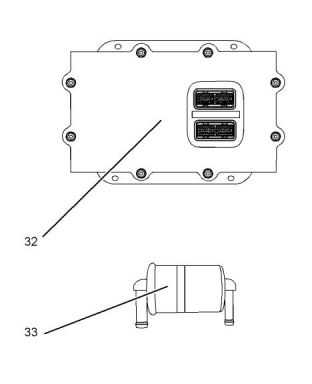
![]()
![]()
KENR9144
11
Systems Operation Section
Data Link – The Data Link is a serial communication
port that is used for communication with other
microprocessor-based devices.
operation under all conditions. The electronic engine
control also controls the engine operation under all
conditions.
Derate – Certain engine conditions will generate
event codes. Also, engine derates may be applied.
The map for the engine derate is programmed into
the ECM software. The derate can be one or more of
three types: reduction of rated power, reduction of
rated engine speed and reduction of rated machine
speed for OEM products.
Engine Control Module (ECM) – The ECM is the
control computer of the engine. The ECM provides
power to the electronics. The ECM monitors data that
is input from the sensors of the engine. The ECM acts
as a governor in order to control the speed and the
power of the engine.
Electronic Service Tool – The electronic service tool
allows a computer (PC) to communicate with the
ECM.
Desired Engine Speed – The desired engine speed
is input to the electronic governor within the ECM.
The electronic governor uses the signal from the
throttle position sensor, the engine speed sensor, and
other sensors in order to determine the desired
engine speed.
Engine Monitoring – Engine Monitoring is the part of
the electronic engine control that monitors the
sensors. This also warns the operator of detected
problems.
Diagnostic Trouble Code – A diagnostic trouble
code is sometimes referred to as a fault code. These
codes indicate an electronic system malfunction.
Engine Oil Pressure Switch – The engine oil
pressure switch provides a warning of low engine oil
pressure. The switch controls a warning lamp at the
operator position.
Diagnostic Lamp – A diagnostic lamp is sometimes
called the check engine lamp. The diagnostic lamp is
used to warn the operator of the presence of an
active diagnostic code. The lamp may not be included
in all applications.
Engine Speed Sensor – An engine speed sensor is
a Hall effect sensor that provides a digital signal to
the ECM. The ECM interprets this signal as the
engine speed. Two sensors are used to provide the
speed signals to the ECM. The primary sensor and
the secondary sensor are associated with the
crankshaft.
Diesel Oxidation Catalyst – The Diesel Oxidation
Catalyst is also known as the (DOC). The DOC is a
device in the exhaust system that oxidizes certain
elements in the exhaust gases. These elements can
include carbon monoxide (CO), hydrocarbons and the
soluble organic fraction (SOF) of particulate matter.
Event Code – An event code may be activated in
order to indicate an abnormal engine operating
condition. These codes usually indicate a mechanical
problem instead of an electrical system problem.
Diesel Particulate Filter – The Diesel Particulate
Filter (DPF) filters particulates from the exhaust
gases. When the particulates have built up on the
internal surfaces of the DPF, the temperature of the
exhaust gas is raised by the Aftertreatment
Regeneration Device (ARD) in order to burn off the
particulates. This regeneration process prevents the
DPF from becoming blocked. The regeneration
process therefore allows the DPF to continue to
operate efficiently.
Failure Mode Identifier (FMI) – This identifier
indicates the type of failure that is associated with the
component. The FMI has been adopted from the SAE
practice of J1587 diagnostics. The FMI follows the
parameter identifier (PID) in the descriptions of the
fault code. The descriptions of the FMIs that are used
on these engines are in the following list:
0 – The data is valid but the data is above the normal
operational range.
Digital Sensor Return – The common line (ground)
from the ECM is used as ground for the digital
sensors.
1 – The data is valid but the data is below the normal
operational range.
3 – The voltage is above normal or the voltage is
Digital Sensors – Digital sensors produce a pulse
width modulated signal. Digital sensors are supplied
with power from the ECM.
shorted high.
4 – The voltage is below normal or the voltage is
shorted low.
Digital Sensor Supply – The power supply for the
digital sensors is provided by the ECM.
6 – The current is above normal or the circuit is
grounded.
Direct Current (DC) – Direct current is the type of
current that flows consistently in only one direction.
7 – The mechanical system is not responding
properly.
DT, DT Connector, or Deutsch DT – This is a type
of connector that is used on the engines. The
connectors are manufactured by Deutsch .
8 – There is an abnormal frequency, an abnormal
pulse width, or an abnormal time period.
10 – There is an abnormal rate of change.
11 – The failure mode is not identifiable.
12 – The device or the component is damaged.
Duty Cycle – Refer to “Pulse Width Modulation” .
Electronic Engine Control – The electronic engine
control is a complete electronic system. The
electronic engine control monitors the engine
This document is printed from SPI². Not for RESALE
![]()
12
KENR9144
Systems Operation Section
13 – The device requires calibration.
Inlet Manifold Air Temperature Sensor – The inlet
manifold air temperature sensor detects the air
temperature in the inlet manifold.
14 – There is a special instruction for the device.
15 – The signal from the device is high (least severe)
.
Inlet Manifold Pressure Sensor – The Inlet Manifold
Pressure Sensor measures the pressure in the inlet
manifold. The pressure in the inlet manifold may be
different to the pressure outside the engine
(atmospheric pressure). The difference in pressure
may be caused by an increase in air pressure by a
turbocharger.
16 – The signal from the device is high (moderate
severity) .
31 – The device has failed and the engine has shut
down.
Integrated Electronic Controls – The engine is
designed with the electronic controls as a necessary
part of the system. The engine will not operate
without the electronic controls.
Flash File – This file is software that is inside the
ECM. The file contains all the instructions (software)
for the ECM and the file contains the performance
maps for a specific engine. The file may be
reprogrammed through flash programming.
J1939 CAN Data Link – This data link is a SAE
standard diagnostic communications data link that is
used to communicate between the ECM and other
electronic devices.
Flash Programming – Flash programming is the
method of programming or updating an ECM with an
electronic service tool over the data link instead of
replacing components.
Logged Diagnostic Codes – Logged diagnostic
codes are codes which are stored in the memory.
These codes are an indicator of possible causes for
intermittent problems. Refer to the term “Diagnostic
Code” for more information.
Fuel Injection Pump – This is a device that supplies
fuel under pressure to the fuel injectors and controls
the injection timing.
Fuel Ratio Control (FRC) – The FRC is a limit that is
based on the control of the ratio of the fuel to air. The
FRC is used for purposes of emission control. When
the ECM senses a lower inlet manifold air pressure
(less air into the cylinder), the FRC decreases the
FRC Limit (less fuel into the cylinder).
NOx Reduction System – The NOx Reduction
System recycles a portion of the exhaust gases back
into the inlet air in order to reduce the formation of
nitrous oxide (NOx) in the combustion process. The
recycled exhaust gas passes through a cooler before
being introduced into the inlet air.
Full Load Setting (FLS) – The FLS is the number
that represents the fuel system adjustment. This
adjustment is made at the factory in order to fine-tune
the fuel system. The correct value for this parameter
is stamped on the engine information ratings plate.
This parameter must be programmed.
OEM – OEM is an abbreviation for the Original
Equipment Manufacturer. This is the manufacturer of
the application that uses the engine.
Open Circuit – An open circuit is a condition that is
caused by an open switch, or by an electrical wire or
a connection that is broken. When this condition
exists, the signal or the supply voltage can no longer
reach the intended destination.
Full Torque Setting (FTS) – The FTS is the
parameter that represents the adjustment for the
engine torque. This adjustment is made at the factory
in order to fine-tune the fuel system. This adjustment
is made with the FLS. This parameter must be
programmed.
Parameter – A parameter is a value or a limit that is
programmable. This helps determine specific
characteristics or behaviors of the engine.
Glow Plug – The glow plug is an optional starting aid
for cold conditions. One glow plug is installed in each
combustion chamber in order to improve the ability of
the engine to start. The ECM uses information from
the engine sensors such as the engine temperature
to determine when the glow plug relay must provide
power to each glow plug. Each of the glow plugs then
provides a very hot surface in the combustion
chamber in order to vaporize the mixture of air and
fuel. This improves ignition during the compression
stroke of the cylinder.
Password – A password is a group of numeric
characters or a group of alphanumeric characters that
is designed to restrict access to parameters.
Power Cycling – Power cycling refers to the action of
cycling the keyswitch from any position to the OFF
position, and to the START/RUN position.
Programmable Software – The software is
programmed into the ECM. The software contains all
the instructions (software) for the ECM and the
software contains the performance maps for a
specific engine. The software may be reprogrammed
through flash programming.
Glow Plug Relay – The glow plug relay is controlled
by the ECM in order to provide high current to the
glow plugs that are used in the starting aid system.
Primary Speed Sensor – This sensor determines
the position of the crankshaft during engine operation.
If the primary speed sensor fails during engine
operation, the secondary speed sensor is used to
provide the signal.
Harness – The harness is the bundle of wiring (loom)
that connects all components of the electronic
system.
Hertz (Hz) – Hertz is the unit of frequency in cycles
per second.
This document is printed from SPI². Not for RESALE
![]()
KENR9144
13
Systems Operation Section
Pulse Width Modulation (PWM) – The PWM is a
signal that consists of pulses that are of variable
width. These pulses occur at fixed intervals. The ratio
of “TIME ON” versus total “TIME OFF” can be
varied. This ratio is also referred to as a duty cycle.
Signal – The signal is a voltage or a waveform that is
used in order to transmit information typically from a
sensor to the ECM.
Supply Voltage – The supply voltage is a continuous
voltage that is supplied to a component in order to
provide the electrical power that is required for the
component to operate. The power may be generated
by the ECM or the power may be battery voltage that
is supplied by the engine wiring.
System Configuration Parameters – System
configuration parameters are parameters that affect
emissions and/or operating characteristics of the
engine.
Tattletale – Certain parameters that affect the
operation of the engine are stored in the ECM. These
parameters can be changed by use of the electronic
service tool. The tattletale logs the number of
changes that have been made to the parameter. The
tattletale is stored in the ECM.
“T” Harness – This harness is a test harness that is
designed to permit normal circuit operation and the
measurement of the voltage simultaneously.
Typically, the harness is inserted between the two
ends of a connector.
Throttle Position – The throttle position is the
interpretation by the ECM of the signal from the
throttle position sensor or the throttle switch.
Illustration 7
g01858875
Rated Fuel Limit – This is a limit that is based on the
power rating of the engine and on the engine rpm.
The Rated Fuel Limit enables the engine power and
torque outputs to conform to the power and torque
curves of a specific engine model. These limits are in
the flash file and these limits cannot be changed.
Throttle Position Sensor – The throttle position
sensor is an electronic sensor that is usually
connected to an accelerator pedal or a hand lever.
This sensor sends a signal to the ECM that is used to
calculate desired engine speed.
Top Center Position – The top center position refers
to the crankshaft position when the engine piston
position is at the highest point of travel. The engine
must be turned in the normal direction of rotation in
order to reach this point.
Reference Voltage – Reference voltage is a
regulated voltage and a steady voltage that is
supplied by the ECM to a sensor. The reference
voltage is used by the sensor to generate a signal
voltage.
Total Tattletale – The total tattletale is the total
number of changes to all the parameters that are
stored in the ECM.
Relay – A relay is an electromechanical switch. A
flow of electricity in one circuit is used to control the
flow of electricity in another circuit. A small current or
voltage is applied to a relay in order to switch a much
larger current or voltage.
Wait To Start Lamp – This is a lamp that is included
in the cold starting aid circuit in order to indicate when
the wait to start period is active. The lamp will go off
when the engine is ready to be started. The glow
plugs may not have deactivated at this point in time.
Secondary Speed Sensor – This sensor determines
the position of the camshaft during engine operation.
If the primary speed sensor fails during engine
operation, the secondary speed sensor is used to
provide the signal.
Wastegate – This is a device in a turbocharged
engine that controls the maximum boost pressure that
is provided to the inlet manifold.
Sensor – A sensor is a device that is used to detect
the current value of pressure or temperature, or
mechanical movement. The information that is
detected is converted into an electrical signal.
Short Circuit – A short circuit is a condition that has
an electrical circuit that is inadvertently connected to
an undesirable point. An example of a short circuit is
a wire which rubs against a vehicle frame and this
rubbing eventually wears off the wire insulation.
Electrical contact with the frame is made and a short
circuit results.
This document is printed from SPI². Not for RESALE
![]()
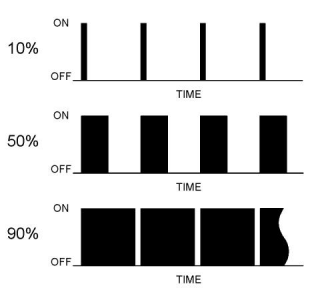
![]()
![]()
14
KENR9144
Systems Operation Section
i05173593
Electronic Control System
Components
The engine has an Electronic Control Module (ECM).
There are also a number of engine sensors. The
ECM controls the engine operating parameters
through the software within the ECM and the inputs
from the various sensors. The software contains
parameters that control the engine operation. The
parameters include all of the operating maps and
customer-selected parameters.
The electronic control system has the following
components:
• ECM
• Pressure sensors
• Temperature sensors
• Crankshaft speed sensors
Illustration 9 is a block diagram of the control system
on a normally aspirated engine. Illustrations 8 and 10
are block diagrams of the control system on
turbocharged engines.
Block diagram for the 403F-15T engine
Illustration 8
g03339508
Typical example
(1) Air cleaner
(2) Air inlet temperaturesensor
(3) Aftertreatment Regeneration Device
(ARD) air pump
This document is printed from SPI². Not for RESALE
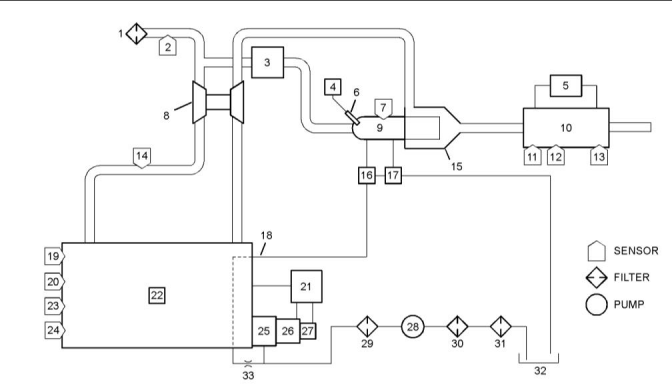
![]()
![]()
KENR9144
15
Systems Operation Section
(4) ARD glow plug relay
(5) Diesel Particulate Filter (DPF) differential
pressure sensor
(6) ARD glow plug
(7) ARD combustion chamber temperature
sensor
(13) DPF outlet temperature sensor
(14) Boost pressure sensor
(15) ARD body
(16) ARD injector No.1
(17) ARD injector No.2
(18) Injector leak-off return line
(19) Coolant temperature sensor
(20) Primary speed sensor
(21) Electronic Control Module (ECM)
(22) Engine
(25) Fuel injection pump and fuel control
rack
(26) Fuel rack actuator
(27) Fuel rack position sensor
(28) Fuel transfer pump
(29) Secondary fuel filter
(30) Primary fuel filter
(31) In line fuel filter
(8) Turbocharger
(9) ARD combustion chamber
(10) Diesel Oxidation Catalyst (DOC) and
DPF
(32) Fuel tank
(33) Fuel restrictor
(11) DOC inlet temperature sensor
(12) DPF inlet temperaturesensor
(23) Oil pressure switch
(24) Engine glow plug relay
This document is printed from SPI². Not for RESALE
![]()
16
KENR9144
Systems Operation Section
Block diagram for the 404F-22 engine
Illustration 9
g03339507
Typical example
(1) Air cleaner
(10) DOC inlet temperature sensor
(22) Engine glow plug relay
(2) Air inlet temperaturesensor
(3) Aftertreatment Regeneration Device
(ARD) air pump
(4) ARD glow plug relay
(5) Diesel Particulate Filter (DPF) differential
pressure sensor
(6) ARD glow plug
(7) ARD combustion chamber temperature
sensor
(11) DPF inlet temperature sensor
(12) DPF outlet temperature sensor
(13) ARD body
(14) ARD injector No.1
(15) ARD injector No.2
(16) Injector leak-off return line
(17) Coolant temperature sensor
(18) Primary speed sensor
(19) Electronic Control Module (ECM)
(20) Engine
(23) Fuel injection pump and fuel control
rack
(24) Fuel rack actuator
(25) Fuel rack position sensor
(26) Fuel transfer pump
(27) Secondary fuel filter
(28) Primary fuel filter
(29) In line fuel filter
(30) Fuel tank
(31) Fuel restrictor
(8) ARD combustion chamber
(9) Diesel Oxidation Catalyst (DOC) and
DPF
(21) Oil pressure switch
This document is printed from SPI². Not for RESALE
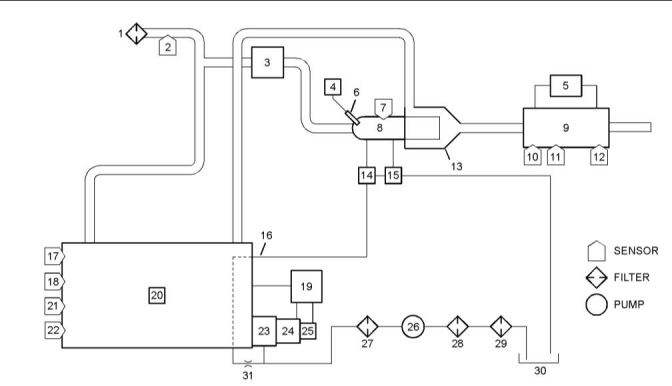
![]()
![]()
KENR9144
17
Systems Operation Section
Block diagram for the 404F-22T engine
Illustration 10
g03339510
Typical example
(1) Air cleaner
(12) DPF inlet temperature sensor
(26) Engine glow plug relay
(2) Air inlet temperaturesensor
(3) Aftertreatment Regeneration Device
(ARD) air pump
(4) ARD glow plug relay
(5) Diesel Particulate Filter (DPF) differential
pressure sensor
(6) ARD glow plug
(7) ARD combustion chamber temperature
sensor
(13) DPF outlet temperature sensor
(14) Boost pressure sensor
(15) ARD body
(16) ARD injector No.1
(17) ARD injector No.2
(27) Fuel injection pump and fuel control
rack
(28) Fuel rack actuator
(29) Fuel rack position sensor
(30) Fuel transfer pump
(31) Secondary fuel filter
(32) Primary fuel filter
(33) In line fuel filter
(18) Valve for the NOx Reduction System
(NRS)
(19) Exhaust gas cooler (NRS)
(20) Injector leak-off return line
(21) Coolant temperature sensor
(22) Primary speed sensor
(23) Electronic Control Module (ECM)
(24) Engine
(34) Fuel tank
(35) Fuel restrictor
(8) Turbocharger
(9) ARD combustion chamber
(10) Diesel Oxidation Catalyst (DOC) and
DPF
(11) DOC inlet temperature sensor
(25) Oil pressure switch
Sensor Locations for the Engine
The illustrations in this section show the typical
locations of the sensors for the industrial engine.
Specific engines may appear different from the
illustration due to differences in applications.
Note: In the following illustrations, some components
have been removed in order to improve visibility.
This document is printed from SPI². Not for RESALE
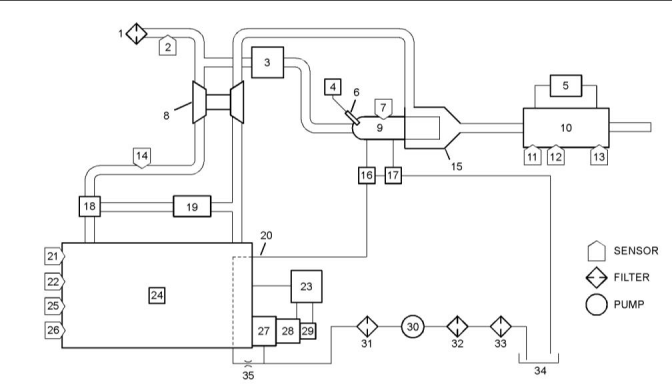
![]()
![]()
18
KENR9144
Systems Operation Section
Illustration 11
g03339512
Sensor locations on the left side of the 403F-15T engine
(1) Coolant temperature sensor
(2) Primary speed sensor
This document is printed from SPI². Not for RESALE
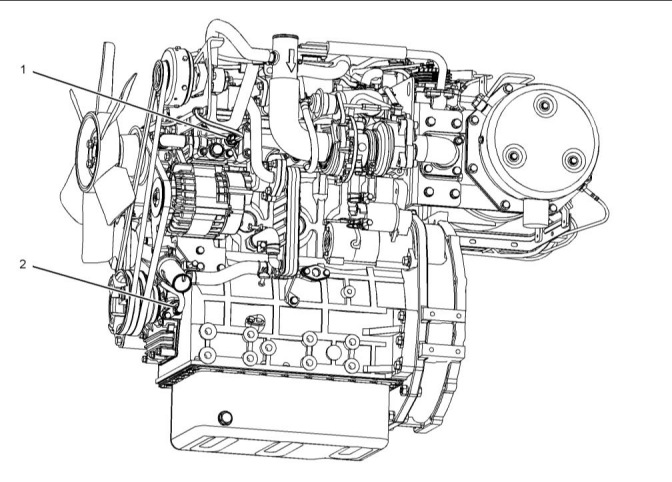
![]()
![]()
KENR9144
19
Systems Operation Section
Illustration 12
g03339513
Close up views of sensor locations on the left side of the 403F-15T engine
(1) Coolant temperature sensor
(2) Primary speed sensor
This document is printed from SPI². Not for RESALE
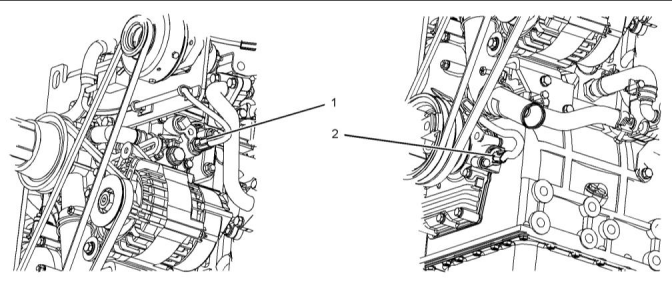
![]()
![]()
20
KENR9144
Systems Operation Section
Illustration 13
g03339514
Sensor and component locations on the top and right side of the 403F-15T engine
(3) DPF differential pressure sensor
(4) ARD glow plug
(5) ARD glow plug resistor
(7) Oil pressure switch
(8) Air inlet temperaturesensor
(9) ARD air pump
(11) Fuel injection pump and fuel control rack
(12) Fuel rack solenoid and position sensor
(13) Electric fuel priming pump
(6) Boost pressure sensor (if equipped)
(10) Secondary speed sensor
This document is printed from SPI². Not for RESALE
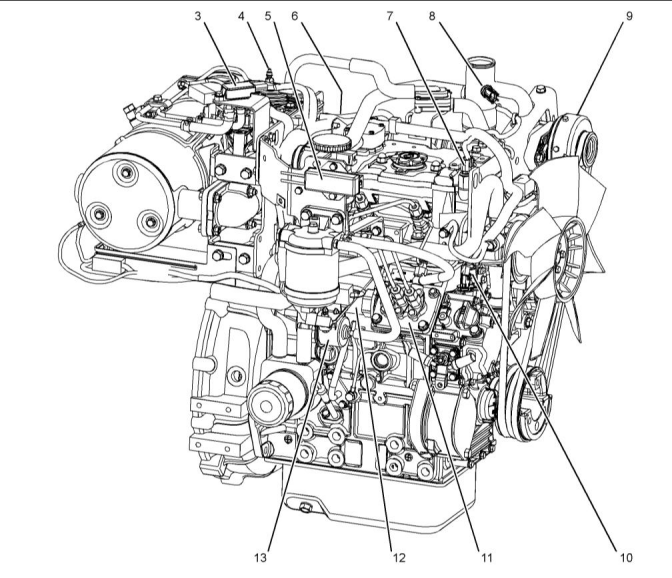
![]()
![]()
KENR9144
21
Systems Operation Section
Illustration 14
g03339515
Close-up views of sensor and component locations on the top and right side of the 403F-15T engine
(3) DPF differential pressure sensor
(4) ARD glow plug
(5) ARD glow plug resistor
(7) Oil pressure switch
(8) Air inlet temperaturesensor
(9) ARD air pump
(11) Fuel pump and fuel rack
(12) Fuel rack solenoid and position sensor
(13) Electric fuel lift pump
(6) Boost pressure sensor (if equipped)
(10) Secondary speed sensor
This document is printed from SPI². Not for RESALE
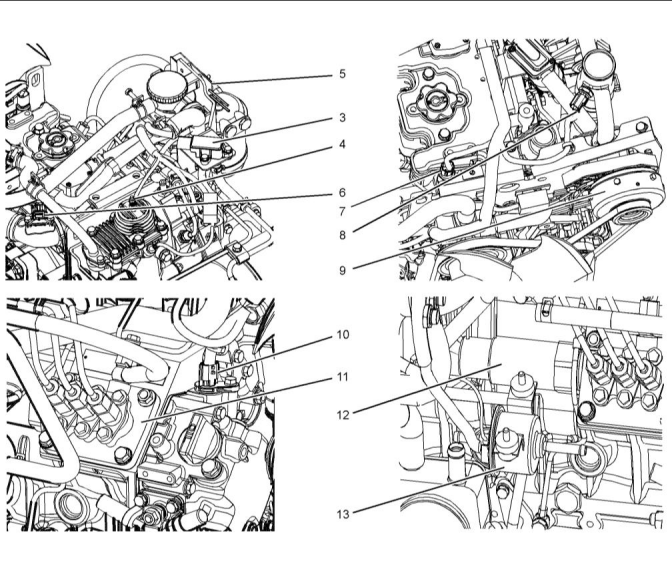
![]()
![]()
22
KENR9144
Systems Operation Section
Illustration 15
g03339516
Typical sensor locations on the left side of the 404F-22 engines
(14) Coolant temperaturesensor
(15) Primary speed sensor
This document is printed from SPI². Not for RESALE
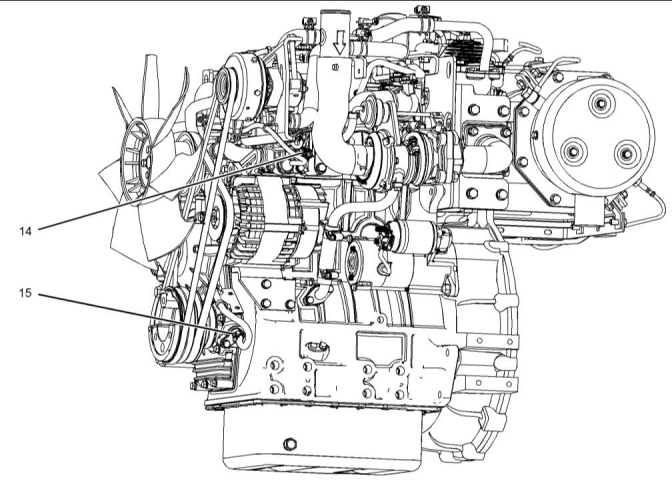
![]()
![]()
KENR9144
23
Systems Operation Section
Illustration 16
g03339517
Close-up views of typical sensor locations on the left side of the 404F-22 engines
(14) Coolant temperaturesensor
(15) Primary speed sensor
This document is printed from SPI². Not for RESALE
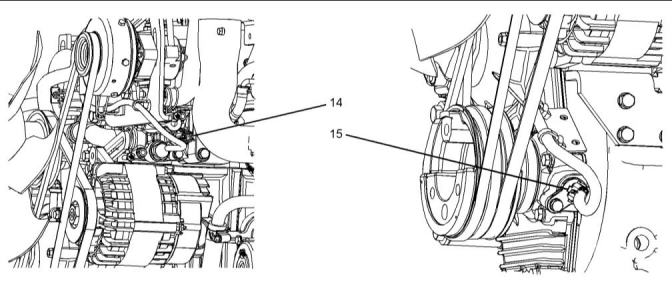
![]()
![]()
24
KENR9144
Systems Operation Section
Illustration 17
g03339518
Typical sensor locations on the right side and top of the 404, F-22 engines
(16) DPF differential pressure sensor
(17) ARD glow plug
(20) Air inlet temperaturesensor
(21) ARD air pump
(23) Fuel injection pump and fuel control
rack
(18) Boost pressure sensor (if equipped)
(19) Oil pressure switch
(22) Secondary speed sensor
(24) Fuel rack solenoid and position sensor
(25) Electric fuel priming pump
This document is printed from SPI². Not for RESALE
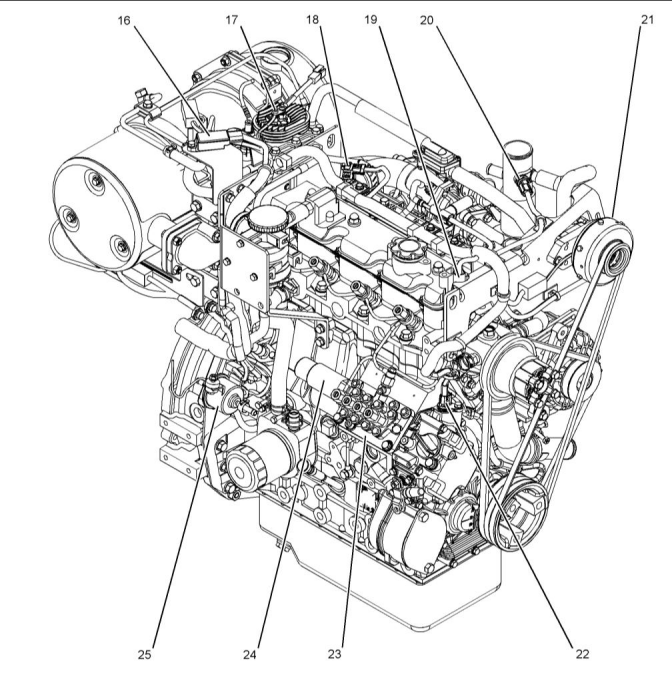
![]()
![]()
KENR9144
25
Systems Operation Section
Illustration 18
g03339520
Close-up views of typical sensor locations on the right side and top of the 404F-22 engines
(16) DPF differential pressure sensor
(17) ARD glow plug
(20) Air inlet temperaturesensor
(21) ARD air pump
(23) Fuel injection pump and fuel control
rack
(18) Boost pressure sensor (if equipped)
(19) Oil pressure switch
(22) Secondary speed sensor
(24) Fuel rack solenoid and position sensor
(25) Electric fuel priming pump
This document is printed from SPI². Not for RESALE
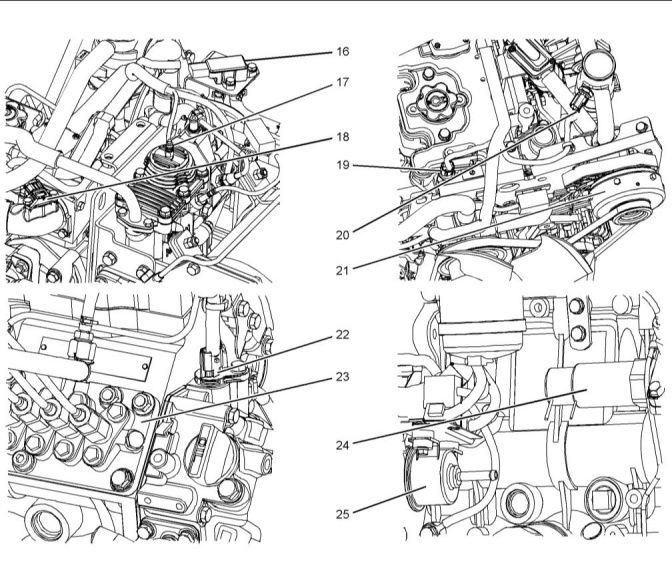
![]()
![]()
26
KENR9144
Systems Operation Section
Sensor Locations for the Clean Emissions Module
Illustration 19
g03339521
Sensors and components on a typical Clean Emissions Module (CEM)
(1) DPF outlet pressure connection
(2) DPF intake pressure connection
(3) DOC intake temperaturesensor
(4) DPF intake temperaturesensor
(5) DPF outlet temperaturesensor
This document is printed from SPI². Not for RESALE
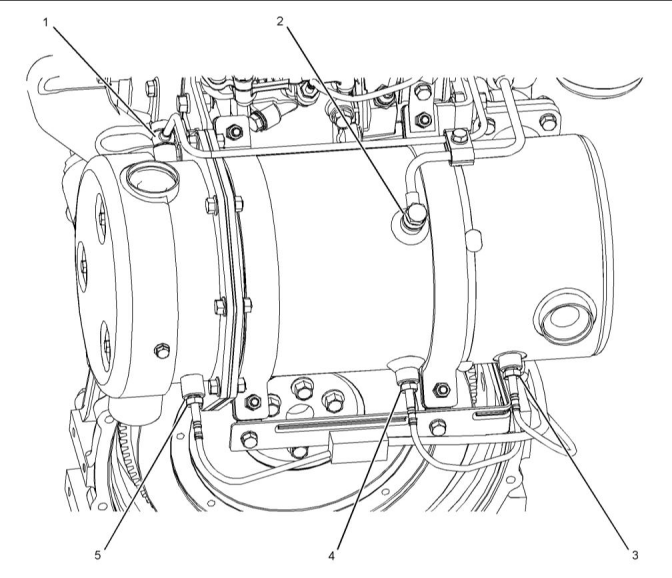
![]()
![]()
KENR9144
27
Systems Operation Section
ECM
Engine Speed
The ECM has software that compares the desired
engine speed to the actual engine speed. The actual
engine speed is determined through the crankshaft
speed sensor. If the desired engine speed is greater
than the actual engine speed, the ECM will instruct
the fuel injection pump to supply more fuel to the fuel
injectors in order to increase engine speed.
Fuel Injection
The programmable software inside the ECM sets
certain limits on the amount of fuel that can be
provided to the fuel injectors.
The ECM controls the following characteristics:
• Operation of the NOx reduction system (if
equipped)
• Regeneration
Diagnostic Codes
Illustration 20
g03322430
When the ECM detects an electronic system
problem, the ECM generates a diagnostic code. Also,
the ECM logs the diagnostic code in order to indicate
the time of the problem's occurrence. The ECM also
logs the number of occurrences of the problem.
Diagnostic codes are provided in order to indicate
that the ECM has detected an electrical problem or
an electronic problem with the engine control system.
In some cases, the engine performance can be
affected when the condition that is causing the code
exists.
Typical example
The Electronic Control Module (ECM) (1) functions as
a computer for the fuel system.
The electronic system consists of the ECM, the
engine sensors, and inputs from the application. The
ECM is the computer. The flash file is the software for
the computer. The flash file contains the operating
maps. The operating maps define the following
characteristics of the engine:
If the operator indicates that a performance problem
occurs, the diagnostic code may indicate the cause of
the problem. Use a laptop computer to access the
diagnostic codes. The problem should then be
corrected.
• Engine rating
• Torque curves
• High and low idle speed (rpm)
• Emissions
Event Codes
The ECM has an excellent record of reliability. Any
problems in the system are most likely to be the
connectors and the wiring harness. The ECM should
be the last item in troubleshooting the engine.
Event Codes are used to indicate that the ECM has
detected an abnormal engine operating condition.
The ECM will log the occurrence of the event code.
This does not indicate an electrical malfunction or an
electronic malfunction. If the temperature of the
coolant in the engine is higher than the permitted
limit, then the ECM will detect the condition. The ECM
will then log an event code for the condition.
The programmable software contains all the fuel
setting information. The information determines the
engine performance.
Speed Sensors
Flash programming is the method of programming or
updating the programmable software. Refer to
Troubleshooting, “Flash Programming” for the
instructions on the flash programming of the
programmable software.
The engine has two speed sensors installed to
measure crankshaft speed.
The ECM is sealed and the ECM needs no routine
adjustment or maintenance.
This document is printed from SPI². Not for RESALE
![]()
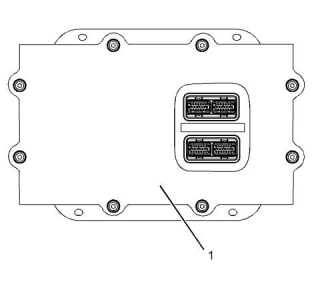
![]()
![]()
28
KENR9144
Systems Operation Section
Illustration 21
g03323793
Typical example
The primary speed sensor (1) is located on the left-
hand side of the engine towards the bottom of the
front housing.
The primary speed sensor generates a signal by
detecting the movement of the crankshaft. The signal
that is generated by the speed sensor is transmitted
to the ECM.
The ECM uses the signal from the speed sensor to
determine the engine speed.
Illustration 22
g03323794
Typical example
The secondary speed sensor (2) is located on the
right-hand side of the engine towards the top of the
front housing.
This document is printed from SPI². Not for RESALE
![]()

![]()
![]()
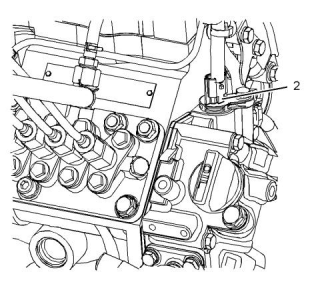
![]()
![]()
KENR9144
29
Systems Operation Section
Illustration 23
g03323790
Typical example
This document is printed from SPI². Not for RESALE

![]()
![]()
30
KENR9144
Systems Operation Section
Pressure Sensors and Switches
Illustration 24
g03323797
Typical example
The boost pressure sensor is an active sensor.
The boost pressure sensor provides the ECM with a
measurement of inlet manifold pressure.
The operating range of the boost pressure sensor is
39 to 400 kPa (6 to 58 psi).
The engine oil pressure switch provides the ECM with
a measurement of engine oil pressure. The ECM can
warn the operator of possible conditions that can
damage the engine. This includes the detection of an
oil filter that is blocked.
The engine oil pressure switch is operated when a
pressure of 50 to 80 kPa (7 to 12 psi) is detected.
This document is printed from SPI². Not for RESALE
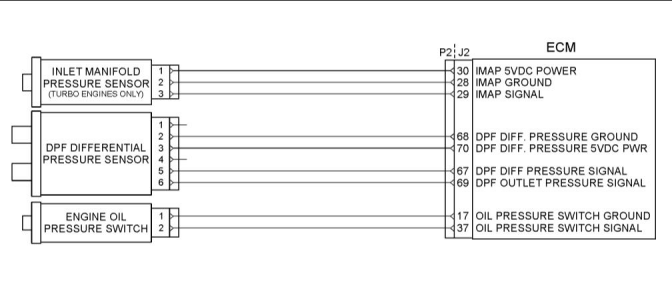
![]()
![]()
KENR9144
31
Systems Operation Section
Temperature Sensors
Illustration 25
g03323798
Typical example
The air inlet temperature sensor and the coolant
temperature sensor are passive sensors. Each
sensor provides a temperature input to the ECM. The
ECM controls following operations:
• Fuel delivery
The operating range for the sensors .....−40° to 130°C
(−40° to 234°F)
The sensors are also used for engine monitoring.
i04904125
Fuel System
General Operation of the Fuel
System
Refer to Systems Operation, Testing, and Adjusting,
“General Information” for locations of the components
for the fuel system.
This document is printed from SPI². Not for RESALE
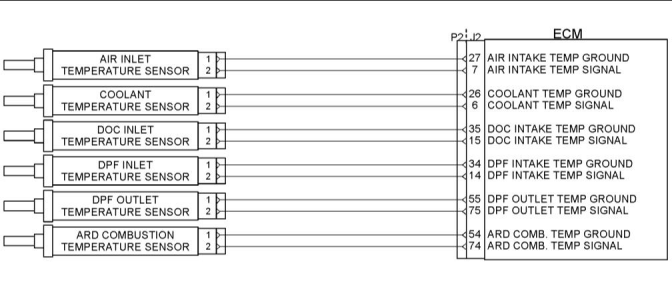
![]()
![]()
32
KENR9144
Systems Operation Section
Illustration 26
g03059777
Typical example
(1) Fuel tank
(2) Primary fuel filter/water separator
(3) Fuel transfer pump
(4) Secondary fuel filter
(5) Fuel injection pump
(6) Fuel injectors
(7) Fuel return line from the fuel injection
pump and the fuel injectors to the fuel
tank
When the engine is cranking, the fuel is pulled from
the fuel tank (1) by the electric fuel transfer pump (3).
A primary fuel filter/water separator (2) is installed
between the fuel tank (1) and the fuel transfer pump
(3). The primary fuel filter/water separator has an
inline style filter. Refer to Operation and Maintenance
Manual for more information on the service of the
primary fuel filter/water separator. The fuel transfer
pump forces the fuel through the secondary fuel filter
(4) to the fuel injection pump (5).
The fuel injection pump sends fuel at high pressure to
each fuel injector nozzle (6). The fuel injector nozzle
sprays fuel into a precombustion chamber which
slows the rate of combustion in the cylinder. The
following items will result from reducing the rate of
fuel combustion: prevention of engine knock,
reduction of noise and reduction of emissions.
The secondary fuel filter (4) can also function as a
water separator. The secondary fuel filter can be
drained through a valve that is located at the bottom
of the filter housing.
This document is printed from SPI². Not for RESALE
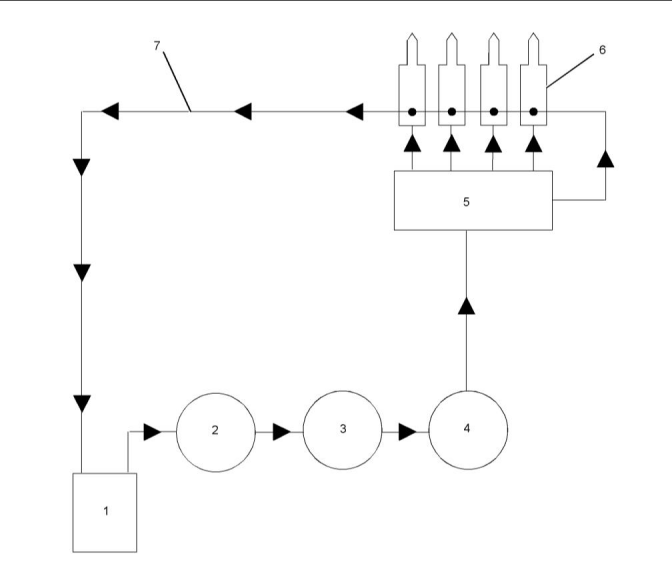
![]()
![]()
KENR9144
33
Systems Operation Section
Governor
The fuel rack is connected to the linkage, which
controls the fuel injection pump. This linkage is
located in the front housing.
These engines have a mechanical governor in order
to control engine speed. The governor operates for all
engine rpm. The governor weight assembly is
installed on the front of the gear of the camshaft. The
other components of the governor are installed in the
front housing.
Illustration 27
g00468241
Phases of operation of the fuel injection nozzle
(A) Closed valve
(B) Open valve
(C) Fully open valve
The fuel injection nozzle injects fuel into the
precombustion chamber at different angles during
two phases. Most of the fuel is injected when the
valve is fully open (C). This process is called indirect
fuel injection. The results are more even combustion
and complete combustion of the fuel at a reduced
temperature. Improved fuel combustion will increase
power output while reducing emissions and reducing
fuel consumption.
Excess fuel from the fuel injection nozzles and the
fuel injection pump flows through fuel return line (7),
through the injectors in the ARD and back to the fuel
tank (1). The excess fuel aids the cooling of the fuel
injection nozzles. Also, the fuel return line removes
any air that is trapped in the fuel injection nozzles and
the fuel injection pump.
Illustration 28
g03335322
Typical example of the governor control mechanism
in the front housing
(1) Connection for the linkage to the fuel injection pump
(2) Control lever
(3) Lever return spring
(4) Governor adjustment screw
(5) Arm
The fuel injection pump needs fuel for lubrication. If
the precision parts of the pump are not adequately
lubricated, the components may be easily damaged.
The engine must not be started until the fuel injection
pump is full of fuel that is free of air.
The movement of the governor weight assembly is
transferred to the fuel rack on the fuel injection pump
by the control lever (2), the governor lever (5), and the
linkage to the fuel injection pump. The governor main
spring (3) connects the governor lever to the control
lever. The governor main spring controls the
movement of the governor weight assembly on the
camshaft. When the angle of the control lever
changes, the tension on the governor main spring
changes. This action controls the linkage to the fuel
rack on the fuel injection pump, which controls the
engine rpm.
The system must be primed by the electric fuel
priming pump when any part of the system is drained
of fuel. The following list contains examples of both
service and repairs when you must prime the system:
• The fuel filter is changed.
• The low-pressure fuel line is removed.
• The fuel injection pump is removed.
• The fuel injection nozzles are removed.
• The fuel tank is drained.
The maximum fuel adjustment screw is mounted in
the front housing. The maximum fuel adjustment
screw is set to the full fuel position. This limits the
maximum fuel that can be injected into the engine in
case the fuel rack solenoid and position sensor is in
fully open position. The fuel rack solenoid and
position sensor controls the fuel delivery by limiting
the mechanical fuel allowance.
• A leak exists in the low-pressure side of the fuel
system.
In order to release air from the fuel injection pump
and the fuel injection nozzles, refer to Systems
Operation, Testing, and Adjusting, “Fuel System -
Prime”.
This document is printed from SPI². Not for RESALE
![]()
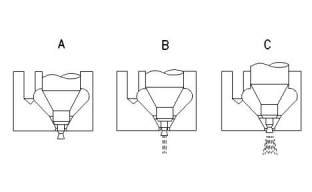
![]()
![]()
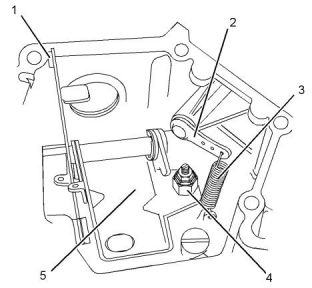
![]()
![]()
34
KENR9144
Systems Operation Section
Adjustments to the pump timing should only be made
by personnel that have had the correct training. The
timing for the fuel injection pump should only change
if the camshaft or the cylinder block are replaced. The
fuel injection pump timing should not change if the
fuel injection pump is reinstalled with a shim that is
the same size.
The fuel injection pump is a pressurized system that
is totally enclosed. The pump sends the correct
amount of fuel under high pressure at the correct time
through the fuel injection nozzles to the individual
cylinders. The fuel injection occurs near the end of
the compression stroke. The fuel injection pump
regulates the amount of fuel that is delivered to the
fuel injection nozzles. This action controls the engine
rpm by the governor setting or the position of the
throttle control.
The fuel rack automatically returns to the excess fuel
position when the engine is stopped. The excess fuel
position aids the cold starting of the engine.
The camshaft is driven by the idler gear in the front
gear case. Lobes on the camshaft cause the pushrod
for each cylinder to reciprocate. The reciprocating
motion first draws the fuel. The reciprocating motion
then pressurizes the fuel. A fuel delivery valve (2) for
each cylinder acts as a check valve in order to
A spring connects the linkage to the fuel injection
pump and mechanical stop control (2). When the
engine is first started, the spring automatically
increases the fuel flow to the cylinders.
Fuel Injection Pump
prevent a loss of pressure to the fuel injection nozzle.
The correct operation of the fuel injection pump
requires the pump to be completely full of fuel and
empty of air. When vent screw (5) is loosened, air can
escape from the fuel injection pump.
The fuel injection pump will lubricate the components
during operation.
Fuel Injection Nozzles
Illustration 29
g00746909
Fuel injection pump (typical example)
(1) Fuel line to the fuel injection nozzles
(2) Fuel delivery valve
(3) Nuts and bolts for mounting the fuel injection pump to the
cylinder block
Illustration 30
g00836660
(1) Fuel injection nozzle
(2) Washer
(4) Shim
(5) Vent screw for the fuel injection pump
(6) Fuel flow from the fuel transfer pump
The washer (2) helps to prevent blowby. The washer
also sets the projection of the fuel injection nozzle (1)
into the precombustion chamber. This projection
affects the time that is required for combustion in the
cylinder. If the projection is excessive, engine knock
can occur at high rpm.
The engines have the energized-to-run system for
starting the engine and stopping the engine. The fuel
rack solenoid and position sensor must be energized
in order for fuel to flow to the engine cylinders.
Note: When a fuel injection nozzle (1) is installed in
the cylinder head, a new washer (2) should be
installed.
The fuel injection pump is a cassette type pump. The
cassette type pump contains the following
components: fuel delivery valves, fuel rack and
pushrods. The fuel injection pump is installed directly
into the cylinder block.
The operating pressure of the fuel injection nozzle is
set and tested at the factory. Refer to Specifications,
“Fuel Injection Nozzles” for the pressure settings of
the fuel injection nozzle.
The part number and code letters for the fuel injection
pump are stamped on the front of the pump.
During operation, extra fuel is used as coolant and
lubricant for components of the fuel injection nozzle.
This document is printed from SPI². Not for RESALE
![]()
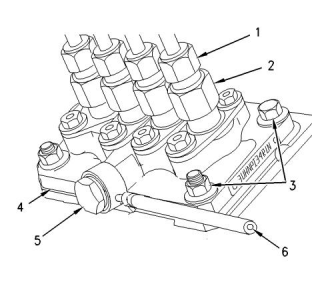
![]()
![]()
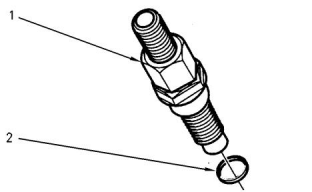
![]()
![]()
KENR9144
35
Systems Operation Section
Fuel Transfer Pump
The mixture of air and fuel is compressed in the
cylinder in order to heat the mixture to the
temperature of combustion.
Power to the electric fuel transfer pump is supplied
through a relay when the keyswitch is turned to the
START position. The motor that is located inside the
electric fuel transfer pump will start to spin. The
electric fuel transfer pump then creates a vacuum in
order to force fuel from the fuel tank. Pressure is
created in order to pump the fuel to the fuel injection
pump.
3. Power
The mixture of air and fuel ignites at the top of the
compression stroke. The expansion of gases from
the combustion forces the piston downward. This
force creates the power of the engine.
The outlet valve and the inlet valve operate as check
valves. The valves maintain residual fuel pressure in
the fuel system when the electric fuel transfer pump is
not operating. The valves also prevent fuel from
flowing in the wrong direction.
4. Exhaust
The piston moves upward in order to force the
gases of combustion from the cylinder through the
open exhaust valve.
Glow Plugs
The sequence of the strokes by all of the pistons in all
of the engine cylinders provides constant air flow from
the air inlet system during the engine operation.
Each cylinder has a glow plug in order to aid the cold
starting of the engine. The glow plugs are controlled
by the Electronic Control Module (ECM).
Turbocharger
In cold ambient temperatures, energizing the glow
plugs for a time period will heat the cylinder
sufficiently for easy starting of the engine.
A turbocharger increases the temperature and the
density of the air that is sent to the engine cylinder.
This condition causes a lower temperature of ignition
to develop earlier in the compression stroke. The
compression stroke is also timed in a more accurate
way with the fuel injection. Surplus air lowers the
temperature of combustion. This surplus air also
provides internal cooling.
Refer to Operation and Maintenance Manual, “Cold
Weather Starting” for the correct method of starting
the engine is cold conditions.
i04904204
A turbocharger improves the following aspects of
engine performance:
Air Inlet and Exhaust System
• Power output is increased.
• Engine torque is increased.
• Engine efficiency is increased.
Naturally aspirated engines pull outside air through
an air cleaner directly into the inlet manifold. The air
flows from the inlet manifold to the engine cylinders.
The fuel is mixed with the air in the engine cylinders.
After the fuel combustion occurs in the engine
cylinder, the exhaust gases flow directly to the outside
air through the exhaust manifold and the exhaust
system.
Turbocharged engines pull outside air through an air
cleaner into the air intake of the turbocharger. The
suction is caused by the turbocharger compressor
wheel. Then, the turbocharger compressor wheel
compresses the air. The air flows through the inlet
manifold which directs an even distribution of the air
to each engine cylinder. Air is pulled into the engine
cylinder during the intake stroke of the piston. Then,
the air is mixed with fuel from the fuel injection
nozzles.
Each piston makes four strokes:
1. Intake
Air is drawn into the cylinder through the open inlet
valve. Fuel is sprayed into the engine by the fuel
injection nozzle.
2. Compression
This document is printed from SPI². Not for RESALE
![]()
36
KENR9144
Systems Operation Section
NOx Reduction System (NRS) -
Turbocharged Engines
The NOx Reduction System (NRS) operates with the
transfer of the hot exhaust gas from the exhaust
manifold to the exhaust cooler. The hot exhaust gas
is cooled in the exhaust cooler. The now cooled
exhaust gas passes through the assembly of the
exhaust gas valve to an electronic controlled valve.
The electronically controlled valve is electronically
actuated. The valve is controlled by the Electronic
Control Module (ECM).
The reed valves that are located in the exhaust gas
valve (NRS) have two main functions. The first
function is to prevent the reverse flow of charge air
from the inlet side of the engine to the exhaust side of
the engine. The second function of the reed valve is
to obtain exhaust gas when the peak exhaust
pressure is above the average inlet pressure.
The electronically controlled valve opens to allow the
flow of cooled exhaust gas from the exhaust cooler to
mix with the air flow from the inlet. The mixing of the
cooled exhaust gas and the air flow from the inlet
reduces the oxygen content of the gas mixture. This
results in a lower combustion temperature, so
decreases the production of NOx.
Illustration 31
g00302786
Components of a turbocharger (typical example)
(1) Air intake
(2) Compressor housing
(3) Compressor wheel
(4) Bearing
In some instances, the engine will need to use the
electronically controlled exhaust gas valve for the
NOx Reduction System (NRS) in order to generate
the required flow of exhaust gas.
(5) Oil inlet port
(6) Bearing
(7) Turbine housing
(8) Turbine wheel
(9) Exhaust outlet
(10) Oil outlet port
(11) Exhaust inlet
Cylinder Head And Valves
A turbocharger is installed between the exhaust and
intake manifolds. The turbocharger is driven by
exhaust gases which flow through the exhaust inlet
(11). The energy of the exhaust gas turns the turbine
wheel (8). Then, the exhaust gas flows out of the
turbine housing (7) through the exhaust outlet (9).
Turbine wheel (8) and compressor wheel (3) are
installed on the same shaft. Therefore, turbine wheel
(8) and compressor wheel (3) rotate at the same rpm.
The compressor wheel is enclosed by compressor
housing (2). The compressor wheel compresses the
intake air. The intake air flows into the engine
cylinders through the inlet valves of the cylinders.
The oil from the main gallery of the cylinder block
flows through the oil inlet port (5) in order to lubricate
the turbocharger bearings (4) and (6). The
pressurized oil passes through the bearing housing of
the turbocharger. The oil is returned through the oil
outlet port (10) to the oil pan.
The turbocharger has a wastegate. The wastegate is
controlled by the boost pressure. This allows some of
the exhaust gases to bypass the turbine wheel at
higher engine speeds. The wastegate is a type of
flapper valve that automatically opens at a preset
level of boost pressure in order to allow exhaust gas
to flow around the turbine. The wastegate allows the
design of the turbocharger to be more effective at
lower engine speeds.
Illustration 32
g00905459
Cross section of the inlet and exhaust valves in the
cylinder head (typical example)
This document is printed from SPI². Not for RESALE
![]()
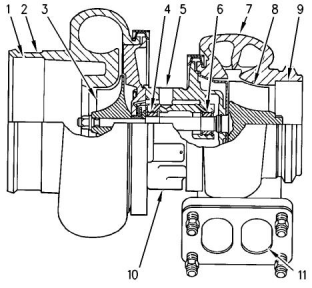
![]()
![]()
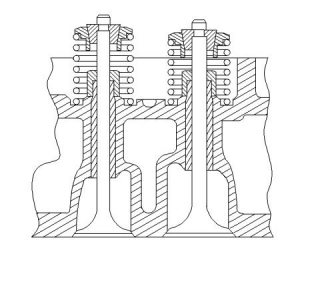
![]()
![]()
KENR9144
37
Systems Operation Section
The camshaft gear is driven by the idler gear. The
camshaft gear, the idler gear, and the crankshaft gear
are timed together. When the camshaft turns, the
valve lifters are moved up and down. The pushrods
move the rocker arms. The rocker arms make the
inlet valves and the exhaust valves open and close.
This is in sequence with the firing order of the engine.
The valve springs force the valves back to the closed
position.
Crankcase Breather
NOTICE
The crankcase breather gases are part of the engines
measured emissions output. Any tampering with the
breather system could invalidate the engines emis-
sions compliance.
The engine has a low-pressure closed circuit breather
system installed.
The valve mechanism cover contains a closed
breather assembly. The breather is sealed from the
outside air by a diaphragm. The gases in the valve
cover, which are caused by blowby, pass from the
crankcase to the next component depending on the
type of aspiration system the engine has.
Illustration 33
g00905464
Cylinder head and valves (typical example)
(1) Collets
(2) Valve spring retainer
(3) Valve spring
(4) Valve seal
On the naturally aspirated engine, the crankcase gas
is recirculated internally directly into the inlet
manifold. The inlet connection is a straight out
connection. The inlet connection contains the inlet
temperature sensor and the air supply for the air
compressor.
(5) Valve guide
(6) Cylinder head
(7) Cylinder head gasket
(8) Pushrod
(9) Lifter
(10) Exhaust valve
(11) Inlet valve
On the turbocharged engine, the crankcase gas is
routed through an external pipe from the valve
mechanism cover to the Oil Mist Separator (OMS).
This uses a filter element to separate the oil vapor
from the blow-by gases. The gas exits the filter. The
gas is then piped into the air inlet hose. The gas then
flows into the turbocharger before entering the engine
again through the inlet manifold.
The valves and the rocker shaft assembly control the
flow of air into the cylinders and out of the cylinders
during engine operation. The cylinder head assembly
has two valves for each cylinder. Each valve has one
valve spring (3). The ports for inlet valve (11) and
exhaust valve (10) are on the left side of the cylinder
head.
The valve moves along a steel valve guide (5). The
valve guides can be replaced.
i04901905
The inlet valve and the exhaust valve are opened and
closed by the rotation and movement of the following
components:
Clean Emissions Module
• Crankshaft
• Idler gear
To meet current emissions legislation requirements, a
small amount of certain chemical compounds that are
emitted by the engine must not be allowed to enter
the atmosphere.
• Camshaft
• Valve lifters
• Pushrods
• Rocker arms
• Valve springs
This document is printed from SPI². Not for RESALE
![]()
![]()
![]()
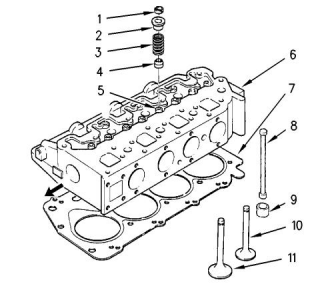
![]()
![]()
38
KENR9144
Systems Operation Section
Illustration 34
g03320982
Typical example
(1) Aftertreatment Regeneration Device
(ARD)
(2) Diesel Oxidation Catalyst (DOC)
(3) Diesel Particulate Filter (DPF)
The CEM for the engine consists of the following
components.
If applicable, a flexible exhaust pipe can connect the
engine to the Clean Emissions Module (CEM). Refer
to Disassembly and Assembly for the correct
procedure to install the flexible exhaust pipe.
• Aftertreatment Regeneration Device (ARD)
• Diesel Oxidation Catalyst (DOC)
• Diesel Particulate Filter (DPF)
The solid particulate matter that is collected by the
DPF consists of soot (carbon) from incomplete
combustion of the fuel and inorganic ash from the
combustion of any oil in the cylinder.
The Diesel Oxidation Catalyst (DOC) oxidizes the
carbon monoxide and the hydrocarbons that are not
burnt in the exhaust gas into carbon dioxide and
water. This is a through flow device that will continue
to operate during all normal engine operating
conditions.
The rate of accumulation of ash is slow. The filter is
designed to contain all the ash that is produced until
the defined service interval. Refer to Operation and
Maintenance Manual for more information.
The soot that is collected must be removed at regular
intervals by a process of regeneration.
The wall flow Diesel Particulate Filter (DPF) collects
all solid particulate matter in the exhaust gas.
The wall flow DPF continuously regenerates at
modest temperatures, using passive regeneration to
continually control soot loading.
The Aftertreatment Regeneration Device (ARD)
increases the exhaust gas temperature to a sufficient
level. The soot that is collected in the DPF is
oxidized.
Active regeneration occurs when the engine does not
create enough heat in order to regenerate the DPF.
This document is printed from SPI². Not for RESALE
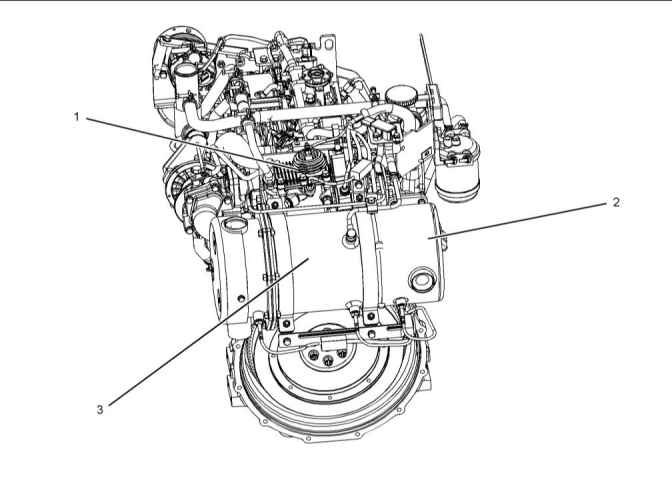
![]()
![]()
KENR9144
39
Systems Operation Section
Air is supplied to the ARD through pressurized air
from the turbocharger and air pump. Fuel is supplied
from the leakoff line to the ARD.
Limited speed strategy – The limited speed strategy
will be activated after the soot level has reached 100
percent. At this time, the engine will automatically
drop to the programmed speed of 1800 rpm with 50
percent engine load. The only method to unlock the
limited speed is to perform a regeneration.
Fuel is injected onto a wire gauze by the first injector.
The fuel is ignited by the glow plug. The ARD is air
cooled.
Forced engine shutdown strategy – The forced
engine shutdown strategy will be activated when the
soot level reaches 140 percent soot level. The engine
will operate between 800 and 1800 rpm. After 30
seconds, the engine will automatically shut down.
The engine can be restarted but will only operate for
30 seconds before shutting down again.
The combustion of the fuel generates heat. Once the
temperature recorded by the inlet temperature sensor
has reached 300° C (572° F), the second injector will
inject fuel into the exhaust gas stream. The fuel from
the second injector ignites when the fuel comes into
contact with the face of the DOC due to the heat
created by first injection event.
Force Switch Regeneration – Regeneration initiated
by the force switch is allowed at all times.
The DOC oxidizes the soot into carbon dioxide, which
then passes through the filter and into the
atmosphere.
Passive Regeneration – Passive regeneration is
allowed at all times.
The ARD may automatically switch ON and OFF. The
ARD may be manually controlled by the operator. The
ARD is controlled by the sensor for the soot level. The
sensor for the level of soot will ensure that the level of
soot in the filter is kept within limits. This is referred to
as a regeneration of the filter.
Active Regeneration – Active regeneration will be
allowed once soot level is greater than 60 percent.
Regeneration Types and Operating
Criteria
In order to regenerate the DPF at the right time, the
engine ECM must know how much soot is in the DPF.
Measurement of soot is accomplished through the
following means:
Regenerations
There are two types of regeneration. These
regenerations are referred to as passive regeneration
and active regeneration.
• Delta pressure measurement across the DPF
• Calculated model based on developed engine out
soot measurements
Passive Regeneration
The soot level may be displayed as a graphical bar,
or as an actual percentage. Soot level can also be
viewed through the electronic service tool.
Passive regeneration occurs when the engine is
operating and the exhaust temperatures reach
sufficient levels.
The frequency of regeneration will depend on the
operating conditions of the engine. The frequency of
regeneration will depend on the ambient conditions of
the operation of the engine. Regeneration will be
most frequent if the application operates with a high
transient content or the atmospheric temperature or
the altitude is high.
Active Regeneration
Active regeneration occurs when the soot load in the
DPF reaches 60 percent. The ARD must be used to
create the heat necessary to regenerate the DPF.
The ARD may perform an active regeneration while
the engine is at any operating condition.
Soot Level Outputs
Active regenerations consume more fuel and take a
shorter time to complete compared to passive
regenerations. This longer time is due to maintaining
lower desired DPF inlet temperatures to avoid
damaging the DPF from extreme changes in
temperature.
The soot level percentage that is generated by the
engine ECM is used in determining:
• When to activate the DPF lamp
• When to activate the DPF and flashing warning
lamp (for high soot load events)
Active regeneration has one distinct operating region.
The operating region is determined by the soot level.
The region is between 60 and 140 percent soot level.
The parameters listed below outline the operating
criteria that are monitored to activate and sustain
active regeneration.
• When to activate the forced engine shutdown
strategy
DPF Lamp – The DPF lamp will be illuminated at a
80 percent soot level on engines.
Note: All of the parameters listed below are
independently developed for each application. All
applications may not meet the exact criteria outlined
below.
DPF and Flashing Warning Lamp – The action lamp
will be illuminated at a 100 percent soot level for
engines. The DPF lamp will remain on with the action
lamp.
This document is printed from SPI². Not for RESALE
![]()
40
KENR9144
Systems Operation Section
Regeneration switch – The disable regeneration
switch is not enabled.
Sensors
Differential Pressure Sensor (DPF ) – This sensor
measures the difference in pressure of the gases as
the gases pass through the DPF.
Engine Coolant Temperature – The engine coolant
temperature should be above 70° C (158° F)
Engine Load Factor – The engine load factor should
be between 0 percent and 80 percent.
Inlet Temperature Sensor – This sensor determines
the temperature of the air that is entering the DOC
and the DPF.
DPF Outlet Temperature – The DPF outlet
temperature should be above 100° C (212° F).
Outlet Temperature Sensor – This sensor
determines the temperature of the air that is exiting
the DPF.
Manual Regenerations
Temperature Sensor – This sensor measures the
temperature within the ARD.
Manual regeneration is accomplished by pressing the
force regeneration switch. Refer to the Operation and
Maintenance Manual for correct location of switch.
Glow Plug
Fuel System for the Clean
Emissions Module
The orifice for the fuel creates a high amount of
atomization of the fuel for ignition and operation.
The fuel is sent directly to the ARD from the leakoff
line for the engine fuel injectors.
i02181303
LubricationSystem
When an active regeneration begins, fuel to the ARD
fuel injectors is controlled by the ECM. The ECM
controls the amount of fuel based on the standard
regeneration control strategy. As the active
regeneration progresses, different levels of fuel are
required by the ARD.
The lubrication system contains the following
components:
Excess fuel for the ARD is then returned to the fuel
tank.
• Oil pump
• Engine oil relief valve
• Engine oil cooler (turbocharged engines)
• Oil filter
Air System for the Clean Emissions
Module
Exhaust Air
• Oil pan
Exhaust air flows from the turbine housing to the
ARD. The exhaust air then flows through the DOC
and the DPF.
• Oil strainer and suction pipe
• Oil level gauge
Combustion Air
• Oil pressure switch
• An oil supply line to the cylinder head
An air pump supplies the pressurized air to the ARD.
There is a reed valve to stop exhaust gas going back
through the system when the air pump is not active.
The oil pump is contained within the idler gear. The
engine oil relief valve is installed in the right side of
the cylinder block.
The air supplied to the ARD is proportional to the
engine speed as the air pump is driven from the
crankshaft.
The oil filter is a spin-on filter that is disposable.
The combustion air is used with the supplied fuel and
the glow plug to ignite the fuel in the wire gauze.
Electronic Controls
All electronic devices on the CEM are controlled by
the engine ECM. The ECM sends signals in order to
complete the following functions: sending fuel
pressure to the ARD, the ignition and the actuation of
the glow plug.
This document is printed from SPI². Not for RESALE
![]()
KENR9144
41
Systems Operation Section
When the engine rpm increases, the flow rate of the
oil pump increases. The increase in the flow rate from
the oil pump causes the pressure to increase. The
relief valve opens if the oil pressure is too high. When
the oil pressure on the plunger of the relief valve is
greater than the force of the spring in the relief valve,
the relief valve opens. The lubricating oil which flows
through the relief valve is returned to the oil pan.
The oil filter is installed on the right side of the
cylinder block. Turbocharged engines have an engine
oil cooler that is installed between the oil filter and the
cylinder block. The oil flows through the oil filter into
the main oil gallery. The main oil gallery is drilled
through the total length of the right side of the cylinder
block.
Illustration 35
g00458938
Oil flows from the main oil gallery through an
externally mounted oil supply line to the cylinder
head. An oil pressure switch measures the oil
pressure at this location. This oil lubricates the rocker
arm assembly. The oil passes through the rocker
shaft to the bore of each rocker arm lever. Then, the
oil flows from the rocker arm levers through holes that
are located in the top of the rocker arm levers. The
valve stems, the valve springs, and the tappets are
lubricated by the splash and the mist of the oil.
Idler gear and components of the oil pump
(1) Snap ring
(2) Collar
(3) Spring
(4) Shim
(5) Oil pump cover
(6) Inner rotor
(7) Spring
(8) Outer rotor
(9) Bush
(10) Idler gear
(11) Thrust washer
The lubricating oil flows through drilled holes in the
main oil gallery to passages in the main journals of
the crankshaft. Then, the oil flows to the main
bearings of the crankshaft. Also, the oil flows through
passages in the crankshaft to the large end bearings
of the connecting rods. The piston bearings, the
pistons, and the cylinder bores are lubricated by the
splash and the mist of the oil.
Pressure for the lubrication system is supplied by an
engine oil pump which uses rotors. The oil pump is
part of the idler gear (10). The idler gear is driven by
the crankshaft gear.
The oil pump has an inner rotor (6) and an outer rotor
(8). The axes of rotation of the rotors are off-center
relative to each other. There is a pin that is inserted
through a hole in the oil pump cover (5) into the outer
rotor. The pin functions as a key in order to keep the
outer rotor in a fixed position with the idler gear.
A hole is located in the bore of each main bearing.
This hole allows oil to flow through passages that
lubricate the journals of the camshaft for the valves.
The bearing for the front journal receives oil from the
front main journal of the crankshaft. The camshaft is
lubricated by the splash of the oil.
The outer rotor is pressed into the bush (9). The bush
is pressed in, to the idler gear (10).
The timing gears are lubricated by the splash of the
oil. Lubricating oil from the timing case returns to the
oil pan.
The inner rotor has four lobes which mesh with the
five lobes of the outer rotor. When the outer lobe
rotates, the distance increases between the lobes of
the outer rotor and the lobes of the inner rotor in order
to create suction. Then, the space between the lobes
is filled with oil. When the distance decreases
between the lobes, pressure is created. This pressure
forces the oil into the chamber for the engine oil relief
valve.
i04903835
Cooling System
Lubricating oil from the oil pan flows through a
strainer and a line to the suction side of the engine oil
pump. The suction side is in the timing gear case.
The lubricating oil flows from the outlet side of the
pump to a relief valve. The relief valve is installed on
the right side of the cylinder block. The lubricating oil,
which flows around the relief valve, flows to the oil
filter.
The coolant system contains the following
components:
This document is printed from SPI². Not for RESALE
![]()
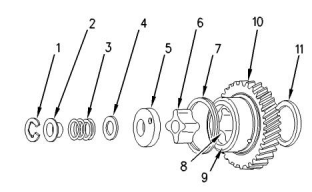
![]()
![]()
42
KENR9144
Systems Operation Section
• Radiator
i04903836
Basic Engine
• Pressure cap for the radiator
• Fan for the radiator
• Drive pulley (if equipped) for the fan
• Water pump
Cylinder Head and Block
The cylinder head assembly has one inlet valve and
one exhaust valve for each cylinder. Each valve has a
single valve spring and a valve seal. The valve and
the valve spring are held in position by a valve spring
retainer and two collets. The valve seal fits over the
top of the valve guide. The valve guides can be
replaced.
• Drive pulley for the water pump
• Water temperature regulator
• Housing for the water temperature regulator
• Coolant temperature switch
The ports for the inlet and for the exhaust valves are
on the left side of the cylinder head.
The coolant flows from the bottom of the radiator to
the centrifugal water pump. The water pump is
installed on the cylinder block above the timing case.
The water pump is driven by a pulley. The crankshaft
pulley turns a belt which drives the pulley of the water
pump.
The cylinder block does not have cylinder liners. The
cylinder walls are honed.
The valve mechanism cover is made from aluminum.
The cover contains the following components:
The water pump forces the coolant to flow to the
water temperature regulator. When the engine is cold,
the water temperature regulator is closed. Then, the
coolant flows directly into the cylinder head. When the
engine warms, the water temperature regulator
begins to open. Then, the regulator allows some of
the coolant to flow to the top of the radiator.
• A closed breather assembly
• An oil filler cap
• A seal for the face toward the cylinder head
• Holes for four cap nuts
The regulator opens fully when the engine reaches
the normal operating temperature. When the
regulator is fully open, the flow to the radiator is the
maximum. However, the regulator does not close the
flow of coolant into the cylinder head.
• Holes for two setscrews
The cap nuts are threaded onto studs. The steel
studs are threaded into the cylinder head.
The setscrews are threaded onto the cover for the
rocker shaft assembly.
Coolant flows continuously through the cylinder head
and the top of the cylinder block. This coolant flows
into the back of the water pump from the cylinder
block. This coolant then mixes with the coolant that is
pumped from the radiator by the water pump.
The valve mechanism cover contains a crankcase
breather. The gases in the valve cover, which are
caused by blowby, pass from the crankcase to the
inlet manifold.
The water temperature regulator maintains the
correct engine temperature by adjusting the direct
flow of coolant to the top of the radiator. The coolant
is cooled by the radiator. Heat is removed from the
coolant by cooler air which passes over the radiator
fins. The fan causes a high volume of air to flow
between the radiator fins in order to provide sufficient
cooling. The coolant flows from the radiator through
the bottom hose to the coolant pump.
Pistons and Connecting Rods
The pistons of the engine have a combustion
chamber in the crown of the piston in order to provide
an efficient mix of the fuel and the air.
The piston pin is off-center in order to reduce the
noise level.
The engine has a housing for the water temperature
regulator. The housing is installed on the left side of
the cylinder head.
The pistons have two compression rings and an oil
control ring.
The correct piston height is important in order to
ensure that the piston does not contact the cylinder
head. The correct piston height also ensures the
efficient combustion of fuel which is necessary in
order to conform to requirements for emissions. The
piston must not be machined in order to obtain the
correct piston height.
The water temperature regulator housing is mounted
vertically.
A piston and connecting rod are matched to each
cylinder.
This document is printed from SPI². Not for RESALE
![]()
KENR9144
43
Systems Operation Section
One height of piston is available. The inside of the
piston is marked “Shibaura” . This reference mark
faces the right side of the engine. Refer to Systems
Operation Testing and Adjusting, “Piston Height -
Inspect” for procedures to measure the piston height.
The crankshaft gear turns the idler gear which then
turns the camshaft gear.
The idler gear contains the oil pump. The idler gear
turns the gear for the tachometer.
Identification marks on the connecting rod and the
connecting rod cap must align. The identification
marks face the right side of the engine.
The crankshaft pulley drives the pulley on the water
pump and the pulley which drives the alternator.
i04906479
The main bearing caps have a chamfered edge on
one side. The chamfer faces the front of the engine.
Electrical System
Timing Gear Case and Gears
The timing gear case contains the following
components:
Engine Electrical System
The electrical system has two separate circuits.
• Charging circuit
• Front oil seal for the crankshaft pulley
• Bearing for the crankshaft gear
• Engine oil pump
• Starting circuit
Some of the electrical system components are used
in more than one circuit. The following items are
common in each of the circuits:
• Adjustment screw for setting the maximum fuel
position
• Adjustment screw for setting the maximum speed
position
• Battery
• Circuit breaker
• Cables
• Mechanical stop control
• Linkage for the fuel injection pump
• Fuel Control lever for the governor
• Throttle
• Wires for the battery
The charging circuit is in operation when the engine is
running. An alternator converts mechanical energy to
electrical energy for the charging circuit. A voltage
regulator in the circuit controls the electrical output in
order to keep the battery at full charge.
The crankshafts for the 403F-15 engines have four
main journal bearings. The crankshafts for the 404F-
22, and 404F-22T engines have five main journal
bearings. The crankshaft has a front bearing that is
pressed in the cylinder block.
NOTICE
The disconnect switch, if equipped, must be in the
ON position in order to let the electrical system func-
tion. There will be damage to some of the charging
circuit components if the engine is running with the
disconnect switch in the OFF position.
The thrust washers are hemispherical in shape. The
403F-15 engines have two thrust washers that are
located on both sides of the bottom half of holder for
the rear main bearing. The 404F-22, and 404F-22T
engines have a third thrust washer that is located on
the rear side of the upper half of the holder for the
rear main bearing.
If the engine has a disconnect switch, the starting
circuit can operate only after the disconnect switch is
put in the “ON” position.
Note: The thrust washers on the 403F-15 engines
are machined into the aluminum holder for the rear
main bearing.
The starting switch is in operation only when the start
switch is activated.
The crankshaft has a front oil seal and a rear oil seal.
The charging circuit is connected through the
ammeter. The starting circuit is not connected through
the ammeter.
The timing case is made of aluminum. The timing
gears are stamped with timing marks in order to
ensure the correct assembly of the gears.
The number one piston is at the top center position on
the compression stroke when the following timing
marks are aligned:
• Idler gear, crankshaft gear and camshaft gear
• Crankshaft pulley and timing case
This document is printed from SPI². Not for RESALE
![]()
![]()
![]()
44
KENR9144
Systems Operation Section
Charging System Components
Regulator
NOTICE
Never operate the alternator without the battery in the
circuit. Making or breaking an alternator connection
with heavy load on the circuit can cause damage to
the regulator.
Alternator
Illustration 37
g00360155
Typical regulator assembly
The voltage regulator is a solid-state electronic
switch. The voltage regulator senses the voltage of
the system. The regulator then uses switches to
control the current to the field windings. This controls
the voltage output in order to meet the electrical
demand of the system.
Starting System Components
Illustration 36
g00292313
Alternator
(1) Regulator
Solenoid
(2) Roller bearing
(3) Stator winding
(4) Ball bearing
(5) Rectifier bridge
(6) Field winding
(7) Rotor assembly
(8) Fan
The alternator is driven by the crankshaft pulley
through a belt. When the engine is running, the pulley
rotates the shaft inside the alternator. The rotor
assembly is attached to the shaft. The rotor assembly
has many magnetic poles. The magnetic poles are
similar to fingers. An air space exists between each of
the opposite poles. The poles have residual
magnetism that produces a small amount of magnet-
like lines of force (magnetic field). This magnetic field
is produced between the poles. As the rotor assembly
begins to turn between the field winding and the
stator windings, a small amount of alternating current
(AC) is produced in the stator windings. The
Illustration 38
g00292316
Typical solenoid schematic
alternating current is produced from the small
magnetic lines of force that are created by the
residual magnetism of the poles. The AC is changed
into direct current (DC) when the current passes
through the diodes of the rectifier bridge. Most of this
current provides the battery charge and the supply for
the low amperage circuit. The remainder of the
current is sent to the field windings. The DC current
flow through the field windings (wires around an iron
core) increases the strength of the magnetic lines of
force. These stronger magnetic lines of force increase
the amount of AC that is produced in the stator
windings. The increased speed of the rotor assembly
also increases the current output of the alternator and
the voltage output of the alternator.
A solenoid is an electromagnetic switch that performs
two basic functions:
• The solenoid closes the high current starting motor
circuit with a low current start switch circuit.
• The solenoid engages the starting motor pinion
with the ring gear.
This document is printed from SPI². Not for RESALE
![]()
![]()
![]()
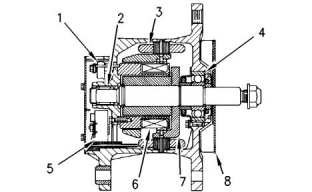
![]()
![]()
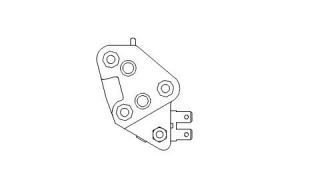
![]()
![]()

![]()
![]()
KENR9144
45
Systems Operation Section
The solenoid has windings (one set or two sets)
around a hollow cylinder. A plunger with a spring load
device is inside of the cylinder. The plunger can move
forward and backward. When the start switch is
closed and electricity is sent through the windings, a
magnetic field is created. The magnetic field pulls the
plunger forward in the cylinder. This moves the shift
lever in order for the pinion drive gear to engage with
the ring gear. The front end of the plunger then makes
contact across the battery and across the motor
terminals of the solenoid. The starting motor then
begins to turn the flywheel of the engine.
The starting motor has a solenoid (2). When the start
switch is activated, solenoid (2) will move starter
pinion (4) in order to engage starter pinion (4) to the
ring gear on the engine flywheel. Starter pinion (4)
and the ring gear will engage when the circuit
between the battery and the starting motor is closed
by the electric contacts in solenoid (2). When the
circuit between the battery and the starting motor is
complete, starter pinion (4) will rotate the engine
flywheel. A clutch provides protection for the starting
motor so that the engine cannot turn the starting
motor too fast. When the switch is released, starter
pinion (4) will move away from the ring gear.
When the start switch is opened, current no longer
flows through the windings. The spring now returns
the plunger to the original position. At the same time,
the spring moves the pinion gear away from the
flywheel.
Other Components
Circuit Breaker
When two sets of windings in the solenoid are used,
the windings are called the hold-in winding and the
pull-in winding. Both of the windings wind around the
cylinder for an equal amount of times. The pull-in
winding uses a wire with a larger diameter in order to
produce a stronger magnetic field. When the start
switch is closed, part of the current flows from the
battery through the hold-in winding. The remainder of
the current flows through the pull-in windings, to the
motor terminal, and then to the ground. When the
solenoid is fully activated, the current is shut off
through the pull-in windings. Only the smaller hold-in
windings are in operation for the extended time period
that is necessary for the engine to be started. The
solenoid will now take a smaller amount of current
from the battery. Heat that is created by the solenoid
will be kept at an acceptable level.
Illustration 40
g00281837
Circuit breaker schematic
Electric Starting Motor
(1) Reset button
(2) Disc in open position
(3) Contacts
(4) Disc
(5) Battery circuit terminals
The circuit breaker is a switch that opens the battery
circuit if the current in the electrical system is higher
than the rating of the circuit breaker. Metal disc (2) is
activated by heat. As the current in the electrical
system increases, the temperature of metal disc (2)
will increase. The heat that is caused by the
excessive current will cause a distortion in metal disc
(2). When a distortion occurs in metal disc (2),
contacts (3) open. A circuit breaker that is open can
be reset when the metal disc becomes cooler. Push
reset button (1) in order to close contacts (3) and
reset the circuit breaker.
Illustration 39
g00292330
Starting motor cross section (typical example)
(1) Field
(2) Solenoid
(3) Clutch
(4) Starter pinion
(5) Commutator
(6) Brush assembly
(7) Armature
The starting motor rotates the engine flywheel at a
rate that is fast enough to start the engine.
This document is printed from SPI². Not for RESALE
![]()
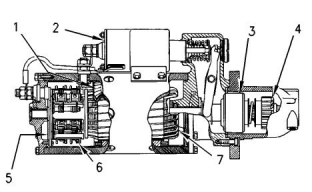
![]()
![]()
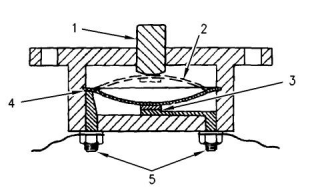
![]()
![]()
46
KENR9144
Fuel System
Testing And Adjusting
Section
Work carefully around an engine that is running.
Engine parts that are hot, or parts that are mov-
ing, can cause personal injury.
Fuel System
2. Install a suitable fuel flow tube with a visual sight
gauge in the fuel return line. When possible, install
the sight gauge in a straight section of the fuel line
that is at least 304.8 mm (12 inch) long. Do not
install the sight gauge near the following devices
that create turbulence:
i04904684
Fuel System - Inspect
• Elbows
A problem with the components that send fuel to the
engine can cause low fuel pressure. This can
decrease engine performance.
• Relief valves
• Check valves
Observe the fuel flow during engine cranking. Look
for air bubbles in the fuel. If there is no fuel that is
present in the sight gauge, prime the fuel system.
Refer to Systems Operation, Testing and
Adjusting, “Fuel System - Prime” for more
information. If the engine starts, check for air in the
fuel at varying engine speeds. When possible,
operate the engine under the conditions which
have been suspect.
1. Check the fuel level in the fuel tank. Ensure that
the vent in the fuel cap is not filled with dirt.
2. Check all fuel lines for fuel leakage. The fuel lines
must be free from restrictions and faulty bends.
Verify that the fuel return line is not collapsed.
3. Inspect the fuel filter for excessive contamination. If
necessary, install a new fuel filter. Determine the
source of the contamination. Make the necessary
repairs.
4. Service the primary fuel filter (if equipped).
5. If necessary, test for air in the fuel. Refer to Testing
and Adjusting, “Air in Fuel - Test” for more
information.
6. Remove any air that may be in the fuel system.
Refer to Testing and Adjusting, “Fuel System -
Prime”.
i05261688
Air in Fuel - Test
This procedure checks for air in the fuel system. This
procedure also assists in finding the source of the air.
1. Examine the fuel system for leaks. Ensure that the
fuel line fittings are properly tightened. Check the
fuel level in the fuel tank. Air can enter the fuel
system on the suction side between the fuel
priming pump and the fuel tank.
Illustration 41
g00578151
(1) A steady stream of small bubbles with a diameter of
approximately 1.60 mm (0.063 inch) is an acceptable amount
of air in the fuel.
(2) Bubbles with a diameter of approximately 6.35 mm (0.250 inch)
are also acceptable if there is 2 seconds to 3 seconds intervals
between bubbles.
(3) Excessive air bubbles in the fuel are not acceptable.
This document is printed from SPI². Not for RESALE
![]()
![]()
![]()
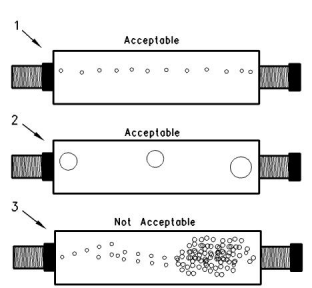
![]()
![]()
KENR9144
47
Fuel System
3. If excessive air is seen in the sight gauge in the fuel
return line, install a second sight gauge at the inlet
to the fuel priming pump. If a second sight gauge is
not available, move the sight gauge from the fuel
return line and install the sight gauge at the inlet to
the fuel priming pump. Observe the fuel flow during
engine cranking. Look for air bubbles in the fuel. If
the engine starts, check for air in the fuel at varying
engine speeds.
If excessive air is not seen at the inlet to the fuel
priming pump, the air is entering the system after
the fuel priming pump. Refer to the Systems
Operation, Testing and Adjusting, “Fuel System -
Prime”.
If excessive air is seen at the inlet to the fuel
priming pump, air is entering through the suction
side of the fuel system.
Illustration 42
g01110251
To avoid personal injury, always wear eye and
face protection when using pressurized air.
1. Remove the valve mechanism cover. Refer to
Disassembly and Assembly, “Valve Mechanism
Cover - Remove and Install”.
NOTICE
To avoid damage, do not use more than 55 kPa
(8 psi) to pressurize the fuel tank.
2. Remove the glow plugs. Refer to Disassembly and
Assembly, “Glow Plugs - Remove and Install”.
3. Rotate the engine crankshaft until the exhaust
valve for No. 1 cylinder is nearly closed and the
inlet valve for No. 1 cylinder is starting to open.
Rotate the crankshaft through approximately 360
degrees and align the timing mark (2) on the
crankshaft pulley with the “TOP” mark (1) on the
timing case.
4. Pressurize the fuel tank to 35 kPa (5 psi). Do not
use more than 55 kPa (8 psi) in order to avoid
damage to the fuel tank. Check for leaks in the fuel
lines between the fuel tank and the fuel priming
pump. Repair any leaks that are found. Ensure that
the fuel transfer pump is operating correctly. Refer
to Systems Operation, Testing and Adjusting, “Fuel
Transfer Pump - Test” for the correct procedure.
4. Install the glow plugs. Refer to Disassembly and
Assembly, “Glow Plugs - Remove and Install”.
5. If the source of the air is not found, disconnect the
supply line from the fuel tank and connect an
external fuel supply to the inlet of the fuel priming
pump. If this corrects the problem, repair the fuel
tank or the stand pipe in the fuel tank.
5. Install the valve mechanism cover. Refer to
Disassembly and Assembly, “Valve Mechanism
Cover - Remove and Install”.
i04904683
i02198351
Fuel Injection Timing - Check
Finding Top Center Position for
No. 1 Piston
Fuel injection timing is set in the factory. Fuel injection
timing cannot change during operation.
This procedure sets the No. 1 piston at the top center
position on the compression stroke.
Note: If a fuel injection pump is removed, replace the
old shims with new shims of the same thickness. Old
shims must not be reused.
This document is printed from SPI². Not for RESALE
![]()
![]()
![]()
![]()
![]()
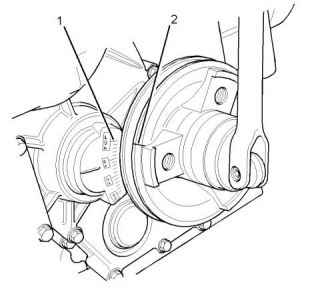
![]()
![]()
48
KENR9144
Fuel System
Note: If the thickness of the shim is 0.5 mm
NOTICE
Use a suitable container to catch any fuel that might
spill. Clean up any spilled fuel immediately.
(0.0197 inch) or the thickness of the shim is below
0.5 mm (0.0197 inch), install beaded shims. If the
shim thickness is above 0.5 mm (0.0197 inch), install
the non-beaded shim. Then install the beaded shim.
Ensure that the beading on the beaded shim faces
upward, toward the bottom of the fuel injection pump.
NOTICE
Do not allow dirt to enter the fuel system. Thoroughly
clean the area around a fuel system component that
will be disconnected. Fit a suitable cover over discon-
nected fuel system component.
Note: If there are three shims installed, the non-
beaded shim is always installed on the inside. If only
one or two shims are installed, all shims are beaded.
On 403F-15T engines, select the correct combination
of shims from table 1 .
Table 1
Shim Thickness (mm)
Part Number
Beaded
0.2
0.25
0.3
131437541
131437740
131437551
131437750
131437561
131437571
131437580
Yes
Yes
Yes
Yes
Yes
Yes
No
0.35
0.4
0.5
0.5
On 404F-22, and 404F-22T engines, select the
correct combination of shims from table 2 .
Table 2
Shim Thickness (mm)
Part Number
Beaded
0.2
0.25
0.3
131437491
131437731
131437501
131437761
131437511
131437521
131437531
Yes
Yes
Yes
Yes
Yes
Yes
No
0.35
0.4
0.5
Illustration 43
g03326638
0.5
Typical example
If the original shim thickness cannot be determined,
contact the Global Technical Support Center. The
user must provide the full engine number of the
product that is serviced.
1. Disconnect the inlet fuel hose (2) to the primary
fuel filter (1).
2. Place end of hose (2) into a suitable container.
i05191126
3. Turn the keyswitch to the START position. The fuel
transfer pump (3) will begin to pump fuel. There will
be the sound of the fuel transfer pump operating.
Fuel Transfer Pump - Test
4. Record the time taken to fill the container with
400 mL (13.6 oz) of fuel. The minimum limit is
400 mL/min (13.6 oz/min).
Fuel leaked or spilled onto hot surfaces or electri-
cal components can cause a fire. To help prevent
possible injury, turn the start switch off when
changing fuel filters or water separator elements.
Clean up fuel spills immediately.
This document is printed from SPI². Not for RESALE

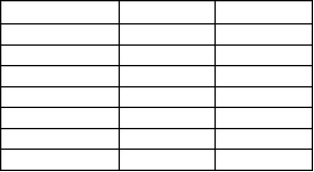
![]()
![]()
![]()
![]()
![]()
![]()
![]()
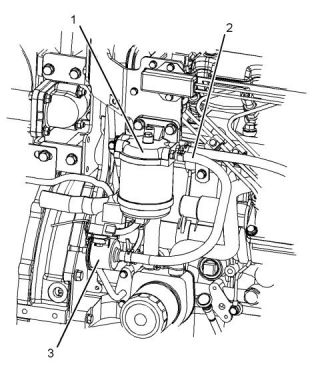
![]()
![]()
KENR9144
49
Fuel System
i02183588
Note: Extra care should be used in handling the fuel
injector in order to prevent damage to the nozzle tip.
A scratch or a burr could cause needle leakage or
spray distortion. Dirt in the orifices of the nozzle tip
can damage engine components. The dirt can also
distort the spray pattern of the nozzle.
Fuel Injector - Test
Perform the following procedures in order to
determine if a fuel injector does not work correctly.
Leakage Test
Illustration 44
g00846800
(1) Fuel injector
(2) Sealing washer
1. Run the engine at low idle.
2. Loosen the nut for the fuel supply line at each fuel
injector (1). Listen for the low idle to decrease or
become rough when the nuts are loosened at each
cylinder.
Illustration 45
g00470020
(1) Adapter
(2) Fuel injector
(3) Tube Assembly
(4) Extension
(5) Fuel Collector
(6) Filter
The fuel injector may be faulty if the following items
occur during the test:
• Engine rpm does not decrease.
This procedure tests for leakage around all
components of the fuel injector.
• The engine continues to run properly.
1. Connect the fuel injector (2) to suitable tooling that
3. If the fuel injector is worn or damaged, remove the
is similar to the Illustration 45 .
fuel injector for additional testing.
Position fuel injector (2) so that the direction of the
fuel spray is into the extension (4) and the fuel
collector (5).
Note: If leakage at the nut for the fuel supply line
occurs, make sure that the fuel supply line and the
nut for the fuel supply line are correctly aligned with
the inlet connection of the fuel injector. Do not tighten
the nut for the fuel supply line on the high pressure
fuel line more than the recommended torque. If the
nut is tightened more, the fuel line may become
restricted or the threads of the fuel injector and the
nut may be damaged.
2. Pump the pressure to about 2030 kPa (294 psi)
below the opening pressure of the fuel injector (2).
Refer to Specifications, “Fuel Injectors” for the
correct setting of the opening pressure.
Release the handle. When the pressure begins to
decrease, note the time that is required for the
pressure to decrease to approximately 0 kPa
(0 psi). If the fuel injector (2) is not faulty, the time
will not be less than 5 seconds or more than 45
seconds.
Inspection and Cleaning of the Fuel
Injectors
Before a fuel injector is tested, remove any loose
carbon from the tip of the nozzle. Do not use abrasive
material or a wire brush in order to clean the nozzle.
If the time that is required for the pressure to
decrease to 0 kPa (0 psi) is less than 5 seconds,
too much fuel is leaking around the valve needle.
Replace fuel injector (2).
This document is printed from SPI². Not for RESALE
